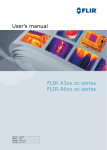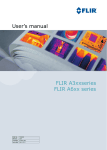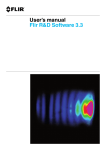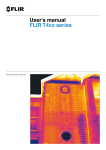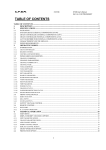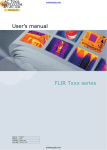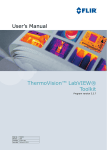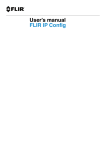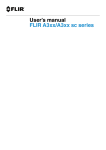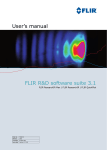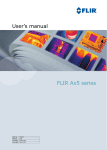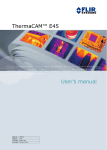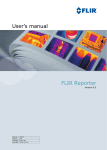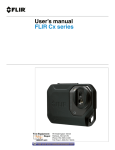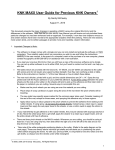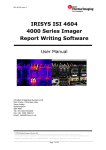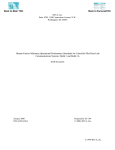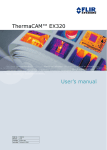Download User`s manual FLIR SC3xx series FLIR SC6xx series
Transcript
User’s manual FLIR SC3xx series FLIR SC6xx series Publ. No. Revision Language Issue date T559499 a547 English (EN) July 21, 2011 User’s manual Publ. No. T559499 Rev. a547 – ENGLISH (EN) – July 21, 2011 Legal disclaimer All products manufactured by FLIR Systems are warranted against defective materials and workmanship for a period of one (1) year from the delivery date of the original purchase, provided such products have been under normal storage, use and service, and in accordance with FLIR Systems instruction. Products which are not manufactured by FLIR Systems but included in systems delivered by FLIR Systems to the original purchaser, carry the warranty, if any, of the particular supplier only. FLIR Systems has no responsibility whatsoever for such products. The warranty extends only to the original purchaser and is not transferable. It is not applicable to any product which has been subjected to misuse, neglect, accident or abnormal conditions of operation. Expendable parts are excluded from the warranty. In the case of a defect in a product covered by this warranty the product must not be further used in order to prevent additional damage. The purchaser shall promptly report any defect to FLIR Systems or this warranty will not apply. FLIR Systems will, at its option, repair or replace any such defective product free of charge if, upon inspection, it proves to be defective in material or workmanship and provided that it is returned to FLIR Systems within the said one-year period. FLIR Systems has no other obligation or liability for defects than those set forth above. No other warranty is expressed or implied. FLIR Systems specifically disclaims the implied warranties of merchantability and fitness for a particular purpose. FLIR Systems shall not be liable for any direct, indirect, special, incidental or consequential loss or damage, whether based on contract, tort or any other legal theory. This warranty shall be governed by Swedish law. Any dispute, controversy or claim arising out of or in connection with this warranty, shall be finally settled by arbitration in accordance with the Rules of the Arbitration Institute of the Stockholm Chamber of Commerce. The place of arbitration shall be Stockholm. The language to be used in the arbitral proceedings shall be English. Copyright © 2011, FLIR Systems. All rights reserved worldwide. No parts of the software including source code may be reproduced, transmitted, transcribed or translated into any language or computer language in any form or by any means, electronic, magnetic, optical, manual or otherwise, without the prior written permission of FLIR Systems. This documentation must not, in whole or part, be copied, photocopied, reproduced, translated or transmitted to any electronic medium or machine readable form without prior consent, in writing, from FLIR Systems. Names and marks appearing on the products herein are either registered trademarks or trademarks of FLIR Systems and/or its subsidiaries. All other trademarks, trade names or company names referenced herein are used for identification only and are the property of their respective owners. Quality assurance The Quality Management System under which these products are developed and manufactured has been certified in accordance with the ISO 9001 standard. FLIR Systems is committed to a policy of continuous development; therefore we reserve the right to make changes and improvements on any of the products described in this manual without prior notice. iv Publ. No. T559499 Rev. a547 – ENGLISH (EN) – July 21, 2011 Table of contents 1 Warnings & Cautions ..................................................................................................................... 1 2 Notice to user .................................................................................................................................. 3 3 Customer help ................................................................................................................................ 5 4 Documentation updates ................................................................................................................. 6 5 Important note about this manual ................................................................................................. 7 6 Overview of camera models .......................................................................................................... 8 6.1 FLIR SC305 ........................................................................................................................... 8 6.2 FLIR SC325 ........................................................................................................................... 9 6.3 FLIR SC645 ........................................................................................................................... 9 6.4 FLIR SC655 ........................................................................................................................... 10 7 Packing list ...................................................................................................................................... 11 8 Installation ....................................................................................................................................... 8.1 General information .............................................................................................................. 8.2 System requirements ........................................................................................................... 8.3 Installation ............................................................................................................................. 12 12 13 14 9 Mechanical installation .................................................................................................................. 9.1 Installation of fixed cameras ................................................................................................. 9.2 Mounting and removing lenses (SC3xx series) ................................................................... 9.2.1 Mounting an additional infrared lens .................................................................... 9.2.2 Removing an additional infrared lens ................................................................... 9.3 Mounting and removing lenses (SC6xx series) ................................................................... 9.3.1 Removing an infrared lens .................................................................................... 9.3.2 Mounting an infrared lens ..................................................................................... 15 15 16 16 17 18 18 19 10 Connectors, controls, and indicators ........................................................................................... 20 11 Example system overviews ........................................................................................................... 24 11.1 SC3xx series ......................................................................................................................... 24 11.2 SC6xx series ......................................................................................................................... 26 12 Cleaning the camera ...................................................................................................................... 12.1 Camera housing, cables, and other items ........................................................................... 12.2 Infrared lens .......................................................................................................................... 12.3 Infrared detector ................................................................................................................... 28 28 29 30 13 Technical data ................................................................................................................................. 31 14 Pin configurations .......................................................................................................................... 32 15 Mechanical drawings ..................................................................................................................... 15.1 SC3xx series ......................................................................................................................... 15.1.1 Camera dimensions (front) ................................................................................... 15.1.2 Camera dimensions (side) ................................................................................... 15.1.3 Camera dimensions (bottom) ............................................................................... Publ. No. T559499 Rev. a547 – ENGLISH (EN) – July 21, 2011 34 34 34 35 36 v 15.2 15.1.4 Camera dimensions (with 10 mm/45° lens) ......................................................... 15.1.5 Camera dimensions (with 30 mm/15° lens) ......................................................... 15.1.6 Infrared lens (10 mm/45°) ..................................................................................... 15.1.7 Infrared lens (30 mm/15°) ..................................................................................... SC6xx series ......................................................................................................................... 15.2.1 Camera dimensions (front view, without lens) ..................................................... 15.2.2 Camera dimensions (side view, without lens) ...................................................... 15.2.3 Camera dimensions (side view, with 24.5 mm/25° lens) ...................................... 15.2.4 Specification of mounting interfaces, #1 ............................................................. 15.2.5 Specification of mounting interfaces, #2 ............................................................. 15.2.6 Camera dimensions (rear view) ............................................................................ 15.2.7 Infrared lens (24.5 mm/25°) .................................................................................. 37 38 39 40 41 41 42 43 44 45 46 47 16 Network troubleshooting ............................................................................................................... 48 17 About FLIR Systems ....................................................................................................................... 17.1 More than just an infrared camera ....................................................................................... 17.2 Sharing our knowledge ........................................................................................................ 17.3 Supporting our customers ................................................................................................... 17.4 A few images from our facilities ........................................................................................... 49 50 51 51 51 18 Glossary ........................................................................................................................................... 53 19 Thermographic measurement techniques ................................................................................... 19.1 Introduction .......................................................................................................................... 19.2 Emissivity .............................................................................................................................. 19.2.1 Finding the emissivity of a sample ....................................................................... 19.2.1.1 Step 1: Determining reflected apparent temperature ....................... 19.2.1.2 Step 2: Determining the emissivity ................................................... 19.3 Reflected apparent temperature .......................................................................................... 19.4 Distance ................................................................................................................................ 19.5 Relative humidity .................................................................................................................. 19.6 Other parameters .................................................................................................................. 57 57 57 58 58 60 61 61 61 61 20 History of infrared technology ...................................................................................................... 62 21 Theory of thermography ................................................................................................................ 21.1 Introduction ........................................................................................................................... 21.2 The electromagnetic spectrum ............................................................................................ 21.3 Blackbody radiation .............................................................................................................. 21.3.1 Planck’s law .......................................................................................................... 21.3.2 Wien’s displacement law ...................................................................................... 21.3.3 Stefan-Boltzmann's law ......................................................................................... 21.3.4 Non-blackbody emitters ....................................................................................... 21.4 Infrared semi-transparent materials ..................................................................................... 66 66 66 67 68 69 71 72 74 22 The measurement formula ............................................................................................................. 76 23 Emissivity tables ............................................................................................................................. 23.1 References ............................................................................................................................ 23.2 Important note about the emissivity tables .......................................................................... 23.3 Tables .................................................................................................................................... vi 82 82 82 83 Publ. No. T559499 Rev. a547 – ENGLISH (EN) – July 21, 2011 1 Warnings & Cautions WARNING ■ ■ ■ This equipment generates, uses, and can radiate radio frequency energy and if not installed and used in accordance with the instruction manual, may cause interference to radio communications. It has been tested and found to comply with the limits for a Class A computing device pursuant to Subpart J of Part 15 of FCC Rules, which are designed to provide reasonable protection against such interference when operated in a commercial environment. Operation of this equipment in a residential area is likely to cause interference in which case the user at his own expense will be required to take whatever measures may be required to correct the interference. (Applies only to cameras with laser pointer:) Do not look directly into the laser beam. The laser beam can cause eye irritation. Applies only to cameras with battery: ■ ■ ■ ■ CAUTION Do not disassemble or do a modification to the battery. The battery contains safety and protection devices which, if they become damaged, can cause the battery to become hot, or cause an explosion or an ignition. If there is a leak from the battery and the fluid gets into your eyes, do not rub your eyes. Flush well with water and immediately get medical care. The battery fluid can cause injury to your eyes if you do not do this. Do not continue to charge the battery if it does not become charged in the specified charging time. If you continue to charge the battery, it can become hot and cause an explosion or ignition. Only use the correct equipment to discharge the battery. If you do not use the correct equipment, you can decrease the performance or the life cycle of the battery. If you do not use the correct equipment, an incorrect flow of current to the battery can occur. This can cause the battery to become hot, or cause an explosion and injury to persons. ■ Make sure that you read all applicable MSDS (Material Safety Data Sheets) and warning labels on containers before you use a liquid: the liquids can be dangerous. ■ Do not point the infrared camera (with or without the lens cover) at intensive energy sources, for example devices that emit laser radiation, or the sun. This can have an unwanted effect on the accuracy of the camera. It can also cause damage to the detector in the camera. Do not use the camera in a temperature higher than +50°C (+122°F), unless specified otherwise in the user documentation. High temperatures can cause damage to the camera. (Applies only to cameras with laser pointer:) Protect the laser pointer with the protective cap when you do not operate the laser pointer. Applies only to cameras with battery: ■ ■ ■ ■ ■ ■ Do not attach the batteries directly to a car’s cigarette lighter socket, unless a specific adapter for connecting the batteries to a cigarette lighter socket is provided by FLIR Systems. Do not connect the positive terminal and the negative terminal of the battery to each other with a metal object (such as wire). Do not get water or salt water on the battery, or permit the battery to get wet. Publ. No. T559499 Rev. a547 – ENGLISH (EN) – July 21, 2011 1 1 – Warnings & Cautions ■ ■ ■ ■ ■ ■ ■ ■ ■ ■ ■ ■ ■ ■ ■ ■ ■ 2 Do not make holes in the battery with objects. Do not hit the battery with a hammer. Do not step on the battery, or apply strong impacts or shocks to it. Do not put the batteries in or near a fire, or into direct sunlight. When the battery becomes hot, the built-in safety equipment becomes energized and can stop the battery charging process. If the battery becomes hot, damage can occur to the safety equipment and this can cause more heat, damage or ignition of the battery. Do not put the battery on a fire or increase the temperature of the battery with heat. Do not put the battery on or near fires, stoves, or other high-temperature locations. Do not solder directly onto the battery. Do not use the battery if, when you use, charge, or store the battery, there is an unusual smell from the battery, the battery feels hot, changes color, changes shape, or is in an unusual condition. Contact your sales office if one or more of these problems occurs. Only use a specified battery charger when you charge the battery. The temperature range through which you can charge the battery is ±0°C to +45°C (+32°F to +113°F), unless specified otherwise in the user documentation. If you charge the battery at temperatures out of this range, it can cause the battery to become hot or to break. It can also decrease the performance or the life cycle of the battery. The temperature range through which you can discharge the battery is −15°C to +50°C (+5°F to +122°F), unless specified otherwise in the user documentation. Use of the battery out of this temperature range can decrease the performance or the life cycle of the battery. When the battery is worn, apply insulation to the terminals with adhesive tape or similar materials before you discard it. Remove any water or moisture on the battery before you install it. Do not apply solvents or similar liquids to the camera, the cables, or other items. This can cause damage. Be careful when you clean the infrared lens. The lens has a delicate anti-reflective coating. Do not clean the infrared lens too vigorously. This can damage the anti-reflective coating. In furnace and other high-temperature applications, you must mount a heatshield on the camera. Using the camera in furnace and other high-temperature applications without a heatshield can cause damage to the camera. (Applies only to cameras with an automatic shutter that can be disabled.) Do not disable the automatic shutter in the camera for a prolonged time period (typically max. 30 minutes). Disabling the shutter for a longer time period may harm, or irreparably damage, the detector. The encapsulation rating is valid only when all openings on the camera are sealed with their designated covers, hatches, or caps. This includes, but is not limited to, compartments for data storage, batteries, and connectors. Publ. No. T559499 Rev. a547 – ENGLISH (EN) – July 21, 2011 2 Notice to user Typographical conventions This manual uses the following typographical conventions: ■ ■ ■ ■ User-to-user forums Semibold is used for menu names, menu commands and labels, and buttons in dialog boxes. Italic is used for important information. Monospace is used for code samples. UPPER CASE is used for names on keys and buttons. Exchange ideas, problems, and infrared solutions with fellow thermographers around the world in our user-to-user forums. To go to the forums, visit: http://www.infraredtraining.com/community/boards/ Calibration (This notice only applies to cameras with measurement capabilities.) We recommend that you send in the camera for calibration once a year. Contact your local sales office for instructions on where to send the camera. Accuracy (This notice only applies to cameras with measurement capabilities.) For very accurate results, we recommend that you wait 5 minutes after you have started the camera before measuring a temperature. For cameras where the detector is cooled by a mechanical cooler, this time period excludes the time it takes to cool down the detector. Disposal of electronic waste 10742803;a1 As with most electronic products, this equipment must be disposed of in an environmentally friendly way, and in accordance with existing regulations for electronic waste. Please contact your FLIR Systems representative for more details. Training To read about infrared training, visit: ■ ■ ■ Additional license information http://www.infraredtraining.com http://www.irtraining.com http://www.irtraining.eu This license permits the user to install and use the software on any compatible computer, provided the software is used on a maximum of two (2) computers at the same time (for example, one laptop computer for on-site data acquisition, and one desktop computer for analysis in the office). Publ. No. T559499 Rev. a547 – ENGLISH (EN) – July 21, 2011 3 2 – Notice to user One (1) back-up copy of the software may also be made for archive purposes. 4 Publ. No. T559499 Rev. a547 – ENGLISH (EN) – July 21, 2011 3 Customer help General For customer help, visit: http://support.flir.com Submitting a question To submit a question to the customer help team, you must be a registered user. It only takes a few minutes to register online. If you only want to search the knowledgebase for existing questions and answers, you do not need to be a registered user. When you want to submit a question, make sure that you have the following information to hand: ■ ■ ■ ■ ■ ■ Downloads The camera model The camera serial number The communication protocol, or method, between the camera and your PC (for example, HDMI, Ethernet, USB™, or FireWire™) Operating system on your PC Microsoft® Office version Full name, publication number, and revision number of the manual On the customer help site you can also download the following: ■ ■ ■ ■ ■ Firmware updates for your infrared camera Program updates for your PC software User documentation Application stories Technical publications Publ. No. T559499 Rev. a547 – ENGLISH (EN) – July 21, 2011 5 4 Documentation updates General Our manuals are updated several times per year, and we also issue product-critical notifications of changes on a regular basis. To access the latest manuals and notifications, go to the Download tab at: http://support.flir.com It only takes a few minutes to register online. In the download area you will also find the latest releases of manuals for our other products, as well as manuals for our historical and obsolete products. 6 Publ. No. T559499 Rev. a547 – ENGLISH (EN) – July 21, 2011 5 Important note about this manual General FLIR Systems issues generic manuals that cover several cameras within a model line. This means that this manual may contain descriptions and explanations that do not apply to your particular camera model. NOTE FLIR Systems reserves the right to discontinue models, software, parts or accessories, and other items, or to change specifications and/or functionality at any time without prior notice. Publ. No. T559499 Rev. a547 – ENGLISH (EN) – July 21, 2011 7 6 Overview of camera models 6.1 FLIR SC305 T638517;a1 The FLIR SC305 camera is an excellent choice for those who want to work in R&D but do not need the highest frame rates or a resolution higher than 320 × 240 pixels. For those who need to use the camera in R&D, it is highly recommended to use the FLIR ResearchIR software from FLIR Systems. Key features: ■ ■ ■ ■ Affordable 16-bit 320 × 240 images @ 9 Hz Start-and-stop recording in ResearchIR using digital input Lenses: 25° included, 15° and 45° optional Typical applications: ■ Entry- or mid-level industrial R&D that doesn't need the highest-speed frame rates 8 Publ. No. T559499 Rev. a547 – ENGLISH (EN) – July 21, 2011 6 – Overview of camera models 6.2 FLIR SC325 T638517;a1 The FLIR SC325 camera is an excellent choice for those who want to work in R&D and need high frame rates but for whom 320 × 240 pixel resolution is sufficient. For those who need to use the camera in R&D, it is highly recommended to use the FLIR ResearchIR software from FLIR Systems. Key features: ■ ■ ■ ■ Affordable 16-bit 320 × 240 images @ 60 Hz Start-and-stop recording in ResearchIR using digital input Lenses: 25° included, 15° and 45° optional Typical applications: ■ Entry- or mid-level industrial R&D 6.3 FLIR SC645 T638518;a1 The FLIR SC645 camera is an excellent choice for those who want to work in R&D but don't need the highest frame rates but do require 640 × 480 pixel resolution. For those who need to use the camera in R&D, it is highly recommended to use the FLIR ResearchIR software from FLIR Systems. Key features: Publ. No. T559499 Rev. a547 – ENGLISH (EN) – July 21, 2011 9 6 – Overview of camera models ■ ■ ■ ■ Affordable 16-bit 640 × 480 images @ 25 Hz Start-and-stop recording in ResearchIR using digital input Lenses: 25° included, 15° and 45° optional Typical applications: ■ Mid- or high-end industrial R&D that doesn't need the highest-speed frame rates 6.4 FLIR SC655 T638518;a1 The FLIR SC655 camera is an excellent choice for those who want to work in R&D and require the highest frame rates and 640 × 480 pixel resolution. For those who need to use the camera in R&D, it is highly recommended to use the FLIR ResearchIR software from FLIR Systems. Key features: ■ ■ ■ ■ ■ Affordable 16-bit 640 x 480 images @ 50 Hz Start-and-stop recording in ResearchIR using digital input Windowing mode: 640 × 240 @ 100 Hz or 640 × 120 @ 200 Hz Lenses: 25° included, 15° and 45° optional Typical applications: ■ Mid- or high-end industrial R&D 10 Publ. No. T559499 Rev. a547 – ENGLISH (EN) – July 21, 2011 7 Packing list General The number of parts and accessories included depends on the camera model and/or customer configuration. Contents ■ ■ ■ ■ ■ ■ ■ ■ ■ ■ ■ ■ ■ ■ ■ ■ NOTE Hard transport case or cardboard box Infrared camera with lens ThermoVision™ System Tools & Utilities CD-ROM Application CD-ROM Calibration certificate Ethernet™ cable Mains cable Power cable, pig-tailed Power supply Printed Getting Started Guide Printed Important Information Guide User documentation CD-ROM Warranty extension card or Registration card six-pole screw terminal (mounted on camera) Hard transport case or cardboard box USB cable FLIR Systems reserves the right to discontinue models, parts or accessories, and other items, or to change specifications at any time without prior notice. Publ. No. T559499 Rev. a547 – ENGLISH (EN) – July 21, 2011 11 8 Installation 8.1 General information Explanation The following programs are included on the ThermoVision™ System Tools & Utilities application CD: ■ ■ ■ ■ Default installation paths ■ ■ ■ ■ NOTE 12 FLIR IP Config: A set-up and configuration program to detect and find FLIR automation and science cameras on a network and automatically assign or manually set IP addresses. FLIR IR Monitor: A program to control FLIR automation and science cameras on a network. You typically use FLIR IR Monitor to change camera settings, lay out measurement tools on the screen, set up alarms, etc. FLIR IR Camera Player: A PC-based remote control and video player for IR cameras from FLIR Systems. A link to a web installation of FLIR AXXX Control & Image Interfaces: An installation that includes Interface Control Documents (ICDs), user documentation and Ccode examples. We recommend that you read through the documentation. C:\Program Files\FLIR Systems\FLIR IP Config C:\Program Files\FLIR Systems\FLIR IR Monitor C:\Program Files\FLIR Systems\FLIR IR Camera Player C:\Program Files\FLIR Systems\AXXX Control & Image Interfaces Functionality in the PC programs is dependent on the camera model. Publ. No. T559499 Rev. a547 – ENGLISH (EN) – July 21, 2011 8 – Installation 8.2 System requirements Operating system ■ ■ ■ Hardware ■ ■ ■ ■ ■ Microsoft® Windows® XP Professional, with Service Pack 2 (SP2) Microsoft® Windows® Vista Ultimate 32-bit Microsoft® Windows® 7, 32- and 64-bit Personal computer with a 2 GHz 32-bit or 64-bit processor 1 GB of RAM, or greater 20 GB of hard disk space Super VGA (1024 × 768) or higher-resolution monitor Support for DirectX 9 graphics with: ■ ■ ■ ■ ■ ■ ■ WDDM driver 128 MB of graphics memory (minimum) Pixel Shader 2.0 (in hardware) 32 bits per pixel DVD-ROM drive Audio output Keyboard and Microsoft® mouse, or a compatible pointing device Software Microsoft® Internet Explorer 6 or later SEE For specific information about system requirements for the operating systems mentioned above, please visit: http://www.microsoft.com/windows/. Publ. No. T559499 Rev. a547 – ENGLISH (EN) – July 21, 2011 13 8 – Installation 8.3 Installation General Last-minute changes and other important information can be found in the read-me file on the CD-ROM. We recommend that you read this file before you install the programs. NOTE ■ ■ ■ ■ Procedure If you experience problems during the installation, please visit our Customer Help by pointing your browser to http://support.flir.com. You must be an Adminstrator or a user with Administrative Rights to install the programs. A complete installation consists of several subinstallations, some of which are from third-party vendors. Do not abort these subinstallations, as they are needed for the complete installation. A complete installation can take up to 10 minutes to complete. Follow this procedure: 1 Close down all applications. 2 Insert the ThermoVision™ System Tools & Utilities CD-ROM into the CDROM drive on the computer. The installation should start automatically. Should the installation not start automatically, start Windows® Explorer and double-click SETUP.HTM on the CD-ROM. 3 Click one of the following: ■ ■ ■ ■ 4 14 Install FLIR IP Config. Install FLIR IR Monitor. Install FLIR Camera Player. Install AXXX Control & Image Interfaces. Follow the on-screen instructions. Publ. No. T559499 Rev. a547 – ENGLISH (EN) – July 21, 2011 9 Mechanical installation 9.1 Installation of fixed cameras Mounting interfaces The camera unit has been designed to allow it to be mounted in any position. The housing has three mounting interfaces – bottom, left, and right – each with the following threaded holes. FLIR SC3XX cameras: ■ ■ 2 × M4 metric threaded holes 1 × UNC ¼-20 standard tripod mount. FLIR SC6XX cameras: ■ ■ Notes on permanent mounting 2 × M4 metric threaded holes 1 × UNC ¼-20 standard tripod mount. If the camera unit is to be permanently mounted at the application site, certain steps are required. The camera unit might need to be enclosed in a protective housing and, depending on the ambient conditions (e.g. temperature), the housing may need to be cooled or heated by means of water or air. In very dusty conditions the installation might also need to have a stream of pressurized air directed at the lens, in order to prevent dust build-up. Vibrations When mounting the camera unit in harsh industrial environments, every precaution should be taken when securing the unit. If the environment exposes the unit to severe vibrations, there may be a need to secure the mounting screws by means of Loctite™ or another industrial brand of threadlocking liquid, as well as to dampen the vibrations by mounting the camera unit on a specially designed base. Further information For further information regarding mounting recommendations and environmental enclosures, contact FLIR Systems. Publ. No. T559499 Rev. a547 – ENGLISH (EN) – July 21, 2011 15 9 – Mechanical installation 9.2 Mounting and removing lenses (SC3xx series) 9.2.1 Mounting an additional infrared lens NOTE Do not touch the lens surface when you mount an infrared lens. If this happens, clean the lens according to the instructions in section 12.2 – Infrared lens on page 29. Procedure Follow this procedure to mount an additional infrared lens: 16 1 Push the lens release button to unlock the lens ring. The lens ring is made of plastic and holds the plastic lens cap. 2 Rotate the lens ring 30° counter-clockwise (looking at the front of the lens). 3 Carefully pull out the lens ring from the bayonet ring. 4 Correctly position the lens in front of the bayonet ring. 5 Carefully push the lens into position. 6 Rotate the lens 30° clockwise (looking at the front of the lens). Publ. No. T559499 Rev. a547 – ENGLISH (EN) – July 21, 2011 9 – Mechanical installation 9.2.2 Removing an additional infrared lens NOTE ■ ■ Procedure Do not touch the lens surface when you remove an infrared lens. If this happens, clean the lens according to the instructions in section 12.2 – Infrared lens on page 29. When you have removed the lens, put the lens caps on the lens immediately, to protect it from dust and fingerprints. Follow this procedure to remove an additional infrared lens: 1 Push the lens release button to unlock the lens. 2 Rotate the lens counter-clockwise 30° (looking at the front of the lens). 3 Carefully pull out the lens from the bayonet ring. 4 Correctly position the lens ring in front of the bayonet ring. 5 Carefully push the lens ring into position. 6 Rotate the lens ring 30° clockwise (looking at the front of the lens). Publ. No. T559499 Rev. a547 – ENGLISH (EN) – July 21, 2011 17 9 – Mechanical installation 9.3 Mounting and removing lenses (SC6xx series) 9.3.1 Removing an infrared lens NOTE ■ ■ Procedure 18 Do not touch the lens surface when you remove an infrared lens. If this happens, clean the lens according to the instructions in section 12.2 – Infrared lens on page 29. When you have removed the lens, put the lens caps on the lens immediately, to protect it from dust and fingerprints. Follow this procedure to remove an infrared lens: 1 Rotate the lens counter-clockwise 30° (looking at the front of the lens). 2 Carefully pull out the lens from the bayonet ring. Publ. No. T559499 Rev. a547 – ENGLISH (EN) – July 21, 2011 9 – Mechanical installation 9.3.2 Mounting an infrared lens NOTE Do not touch the lens surface when you mount an infrared lens. If this happens, clean the lens according to the instructions in section 12.2 – Infrared lens on page 29. Procedure Follow this procedure to mount an infrared lens: 1 Correctly position the lens in front of the bayonet ring. 2 Carefully push the lens into position. 3 Rotate the lens 30° clockwise (looking at the front of the lens) until a click is heard. Publ. No. T559499 Rev. a547 – ENGLISH (EN) – July 21, 2011 19 10 Connectors, controls, and indicators FLIR SC3XX series T638625;a1 Explanation This table explains the figure above: 1 Network cable with an RJ45 connector for Ethernet™ connectivity and PoE™ (dependent on the camera model) Note: Only CAT-6 Ethernet™ cables should be used with this camera. 2 Power cable for 12–24 VDC power in Note: The power connector on the camera is polarity protected. 3 Digital I/O ports, opto-isolated (six-pole screw terminal). Pin configuration: 1 2 3 4 5 6 IN 1 IN 2 OUT 1 OUT 2 I/O + I/O – For a schematic overview of the digital I/O ports, see page 32. 20 Publ. No. T559499 Rev. a547 – ENGLISH (EN) – July 21, 2011 10 – Connectors, controls, and indicators A Power indicator Note: The LEDs indicate the following: B Type of signal Explanation The LED glows continuously orange. The camera is starting up. The LED glows continuously red. An error has been detected. Contact service. The LED glows continuously green. The camera has started. The LED flashes 10 times per second. An error has been detected. Contact service. Hardware reset button (for a factory default reset) Use an unbent paper clip or a similar tool to press the reset button through the small hole on the back of the camera for 5 seconds, then release the button. NOTE Cables for digital I/O ports should be 100 m/328 ft. maximum. Publ. No. T559499 Rev. a547 – ENGLISH (EN) – July 21, 2011 21 10 – Connectors, controls, and indicators FLIR SC6XX series T638542;a1 Explanation This table explains the figure above: 1 Network cable with an RJ45 connector for Ethernet™ connectivity and PoE™ (dependent on the camera model) Note: Only CAT-6 Ethernet™ cables should be used with this camera. 2 Power cable for 12–24 VDC power in Note: The power connector on the camera is polarity protected. 3 USB cable with a USB mini-B connector for control and image transfer. 4 Digital I/O ports, opto-isolated (six-pole screw terminal) Pin configuration: 1 2 3 4 5 6 IN 1 IN 2 OUT 1 OUT 2 I/O + I/O – For a schematic overview of the digital I/O ports, see page 32. 22 Publ. No. T559499 Rev. a547 – ENGLISH (EN) – July 21, 2011 10 – Connectors, controls, and indicators A Power indicator Note: The LEDs indicate the following: B Type of signal Explanation The LED glows continuously orange. The camera is starting up. The LED glows continuously red. An error has been detected. Contact service. The LED glows continuously green. The camera has started. The LED flashes 10 times per second. An error has been detected. Contact service. Hardware reset button (for a factory default reset) Use an unbent paper clip or a similar tool to press the reset button through the small hole on the back of the camera for 5 seconds, then release the button. NOTE Cables for digital I/O ports should be 100 m/328 ft. maximum. Publ. No. T559499 Rev. a547 – ENGLISH (EN) – July 21, 2011 23 11 Example system overviews 11.1 SC3xx series Figure 24 10777303;a2 Publ. No. T559499 Rev. a547 – ENGLISH (EN) – July 21, 2011 11 – Example system overviews Explanation This table explains the figure on the previous page: 1 Computer 2 CAT-6 Ethernet™ cable with RJ45 connectors 3 Laboratory set-up with a FLIR SC3XX camera Publ. No. T559499 Rev. a547 – ENGLISH (EN) – July 21, 2011 25 11 – Example system overviews 11.2 Figure 26 SC6xx series T638543;a1 Publ. No. T559499 Rev. a547 – ENGLISH (EN) – July 21, 2011 11 – Example system overviews Explanation This table explains the figure on the previous page: 1 Computer 2 CAT-6 Ethernet™ cable with RJ45 connectors 3 Laboratory set-up with a FLIR SC6XX camera Publ. No. T559499 Rev. a547 – ENGLISH (EN) – July 21, 2011 27 12 Cleaning the camera 12.1 Camera housing, cables, and other items Liquids Use one of these liquids: ■ ■ Warm water A weak detergent solution Equipment A soft cloth Procedure Follow this procedure: CAUTION 28 1 Soak the cloth in the liquid. 2 Twist the cloth to remove excess liquid. 3 Clean the part with the cloth. Do not apply solvents or similar liquids to the camera, the cables, or other items. This can cause damage. Publ. No. T559499 Rev. a547 – ENGLISH (EN) – July 21, 2011 12 – Cleaning the camera 12.2 Infrared lens Liquids Use one of these liquids: ■ ■ ■ 96% ethyl alcohol (C2H5OH). DEE (= ‘ether’ = diethylether, C4H10O). 50% acetone (= dimethylketone, (CH3)2CO)) + 50% ethyl alcohol (by volume). This liquid prevents drying marks on the lens. Equipment Cotton wool Procedure Follow this procedure: 1 Soak the cotton wool in the liquid. 2 Twist the cotton wool to remove excess liquid. 3 Clean the lens one time only and discard the cotton wool. WARNING Make sure that you read all applicable MSDS (Material Safety Data Sheets) and warning labels on containers before you use a liquid: the liquids can be dangerous. CAUTION ■ ■ Be careful when you clean the infrared lens. The lens has a delicate anti-reflective coating. Do not clean the infrared lens too vigorously. This can damage the anti-reflective coating. Publ. No. T559499 Rev. a547 – ENGLISH (EN) – July 21, 2011 29 12 – Cleaning the camera 12.3 Infrared detector General Even small amounts of dust on the infrared detector can result in major blemishes in the image. To remove any dust from the detector, follow the procedure below. NOTE ■ ■ This section only applies to cameras where removing the lens exposes the infrared detector. In some cases the dust cannot be removed by following this procedure: the infrared detector must be cleaned mechanically. This mechanical cleaning must be carried out by an authorized service partner. CAUTION In Step 2 below, do not use pressurized air from pneumatic air circuits in a workshop, etc., as this air usually contains oil mist to lubricate pneumatic tools. Procedure Follow this procedure: 30 1 Remove the lens from the camera. 2 Use pressurized air from a compressed air canister to blow off the dust. Publ. No. T559499 Rev. a547 – ENGLISH (EN) – July 21, 2011 13 Technical data For technical data, refer to the datasheets on the User Documentation CD-ROM that comes with the camera. Datasheets are also available at http://support.flir.com. Publ. No. T559499 Rev. a547 – ENGLISH (EN) – July 21, 2011 31 14 Pin configuration for I/O connector 32 Pin configurations Pin Configuration 1 IN 1 2 IN 2 3 OUT 1 4 OUT 2 5 I/O + 6 I/O – Publ. No. T559499 Rev. a547 – ENGLISH (EN) – July 21, 2011 14 – Pin configurations Schematic overview of the digital I/O ports 10771603;a1 Publ. No. T559499 Rev. a547 – ENGLISH (EN) – July 21, 2011 33 15 Mechanical drawings 15.1 SC3xx series 15.1.1 Camera dimensions (front) Figure 34 10770303;a1 Publ. No. T559499 Rev. a547 – ENGLISH (EN) – July 21, 2011 15 – Mechanical drawings 15.1.2 Figure Camera dimensions (side) T638626;a1 Publ. No. T559499 Rev. a547 – ENGLISH (EN) – July 21, 2011 35 15 – Mechanical drawings 15.1.3 Figure 36 Camera dimensions (bottom) T638627;a1 Publ. No. T559499 Rev. a547 – ENGLISH (EN) – July 21, 2011 15 – Mechanical drawings 15.1.4 Figure Camera dimensions (with 10 mm/45° lens) T638628;a1 Publ. No. T559499 Rev. a547 – ENGLISH (EN) – July 21, 2011 37 15 – Mechanical drawings 15.1.5 Figure 38 Camera dimensions (with 30 mm/15° lens) T638629;a1 Publ. No. T559499 Rev. a547 – ENGLISH (EN) – July 21, 2011 15 – Mechanical drawings 15.1.6 Figure Infrared lens (10 mm/45°) 10762403;a1 Publ. No. T559499 Rev. a547 – ENGLISH (EN) – July 21, 2011 39 15 – Mechanical drawings 15.1.7 Figure 40 Infrared lens (30 mm/15°) 10762503;a1 Publ. No. T559499 Rev. a547 – ENGLISH (EN) – July 21, 2011 15 – Mechanical drawings 15.2 SC6xx series 15.2.1 Camera dimensions (front view, without lens) Figure T638548;a1 Publ. No. T559499 Rev. a547 – ENGLISH (EN) – July 21, 2011 41 15 – Mechanical drawings 15.2.2 Figure 42 Camera dimensions (side view, without lens) T638546;a1 Publ. No. T559499 Rev. a547 – ENGLISH (EN) – July 21, 2011 15 – Mechanical drawings 15.2.3 Figure Camera dimensions (side view, with 24.5 mm/25° lens) T638545;a1 Publ. No. T559499 Rev. a547 – ENGLISH (EN) – July 21, 2011 43 15 – Mechanical drawings 15.2.4 Figure 44 Specification of mounting interfaces, #1 T638550;a1 Publ. No. T559499 Rev. a547 – ENGLISH (EN) – July 21, 2011 15 – Mechanical drawings 15.2.5 Figure Specification of mounting interfaces, #2 T638544;a1 Publ. No. T559499 Rev. a547 – ENGLISH (EN) – July 21, 2011 45 15 – Mechanical drawings 15.2.6 Figure 46 Camera dimensions (rear view) T638547;a1 Publ. No. T559499 Rev. a547 – ENGLISH (EN) – July 21, 2011 15 – Mechanical drawings 15.2.7 Figure Infrared lens (24.5 mm/25°) T638549;a1 Publ. No. T559499 Rev. a547 – ENGLISH (EN) – July 21, 2011 47 16 Network troubleshooting Try one of the following if you experience network problems: ■ ■ ■ ■ ■ ■ ■ ■ ■ ■ ■ ■ ■ Reset the modem and unplug and replug the Ethernet cable at both ends. Reboot the computer with the cables connected. Swap your Ethernet cable with another cable that is either brand new or known to be in working condition. Connect your Ethernet cable to a different wall socket. If you are still not able to get online, you are probably experiencing a configuration issue. Verify your IP address. Disable Network Bridging. Disable your Wi-Fi connectivity (if you use it) to ensure that the wired Ethernet port is open. Renew the DHCP license. Make sure that the firewall is turned off when you troubleshoot. Make sure that your wireless adapter is switched off. If not, the search for the camera might only look for a wireless connection. Normally a modern computer will handle both crossed and uncrossed cable types automatically, but for troubleshooting purposes try both or use a switch. Turn off any network adapters that are not connected to the camera. For troubleshooting purposes, power both the camera and the computer using a mains adapter. Some laptops turn off the network card to save power when using the battery. If none of these steps help you, contact your ISP. 48 Publ. No. T559499 Rev. a547 – ENGLISH (EN) – July 21, 2011 17 About FLIR Systems FLIR Systems was established in 1978 to pioneer the development of high-performance infrared imaging systems, and is the world leader in the design, manufacture, and marketing of thermal imaging systems for a wide variety of commercial, industrial, and government applications. Today, FLIR Systems embraces five major companies with outstanding achievements in infrared technology since 1958—the Swedish AGEMA Infrared Systems (formerly AGA Infrared Systems), the three United States companies Indigo Systems, FSI, and Inframetrics, and the French company Cedip. In November 2007, Extech Instruments was acquired by FLIR Systems. T638608;a1 Figure 17.1 Patent documents from the early 1960s The company has sold more than 140,000 infrared cameras worldwide for applications such as predictive maintenance, R & D, non-destructive testing, process control and automation, and machine vision, among many others. FLIR Systems has three manufacturing plants in the United States (Portland, OR, Boston, MA, Santa Barbara, CA) and one in Sweden (Stockholm). Since 2007 there is also a manufacturing plant in Tallinn, Estonia. Direct sales offices in Belgium, Brazil, Publ. No. T559499 Rev. a547 – ENGLISH (EN) – July 21, 2011 49 17 – About FLIR Systems China, France, Germany, Great Britain, Hong Kong, Italy, Japan, Korea, Sweden, and the USA—together with a worldwide network of agents and distributors—support our international customer base. FLIR Systems is at the forefront of innovation in the infrared camera industry. We anticipate market demand by constantly improving our existing cameras and developing new ones. The company has set milestones in product design and development such as the introduction of the first battery-operated portable camera for industrial inspections, and the first uncooled infrared camera, to mention just two innovations. 10722703;a2 Figure 17.2 LEFT: Thermovision® Model 661 from 1969. The camera weighed approximately 25 kg (55 lb.), the oscilloscope 20 kg (44 lb.), and the tripod 15 kg (33 lb.). The operator also needed a 220 VAC generator set, and a 10 L (2.6 US gallon) jar with liquid nitrogen. To the left of the oscilloscope the Polaroid attachment (6 kg/13 lb.) can be seen. RIGHT: FLIR i7 from 2009. Weight: 0.34 kg (0.75 lb.), including the battery. FLIR Systems manufactures all vital mechanical and electronic components of the camera systems itself. From detector design and manufacturing, to lenses and system electronics, to final testing and calibration, all production steps are carried out and supervised by our own engineers. The in-depth expertise of these infrared specialists ensures the accuracy and reliability of all vital components that are assembled into your infrared camera. 17.1 More than just an infrared camera At FLIR Systems we recognize that our job is to go beyond just producing the best infrared camera systems. We are committed to enabling all users of our infrared camera systems to work more productively by providing them with the most powerful 50 Publ. No. T559499 Rev. a547 – ENGLISH (EN) – July 21, 2011 17 – About FLIR Systems camera–software combination. Especially tailored software for predictive maintenance, R & D, and process monitoring is developed in-house. Most software is available in a wide variety of languages. We support all our infrared cameras with a wide variety of accessories to adapt your equipment to the most demanding infrared applications. 17.2 Sharing our knowledge Although our cameras are designed to be very user-friendly, there is a lot more to thermography than just knowing how to handle a camera. Therefore, FLIR Systems has founded the Infrared Training Center (ITC), a separate business unit, that provides certified training courses. Attending one of the ITC courses will give you a truly handson learning experience. The staff of the ITC are also there to provide you with any application support you may need in putting infrared theory into practice. 17.3 Supporting our customers FLIR Systems operates a worldwide service network to keep your camera running at all times. If you discover a problem with your camera, local service centers have all the equipment and expertise to solve it within the shortest possible time. Therefore, there is no need to send your camera to the other side of the world or to talk to someone who does not speak your language. 17.4 A few images from our facilities 10401303;a1 Figure 17.3 LEFT: Development of system electronics; RIGHT: Testing of an FPA detector Publ. No. T559499 Rev. a547 – ENGLISH (EN) – July 21, 2011 51 17 – About FLIR Systems 10401403;a1 Figure 17.4 LEFT: Diamond turning machine; RIGHT: Lens polishing 10401503;a1 Figure 17.5 LEFT: Testing of infrared cameras in the climatic chamber; RIGHT: Robot used for camera testing and calibration 52 Publ. No. T559499 Rev. a547 – ENGLISH (EN) – July 21, 2011 18 Glossary Term or expression Explanation absorption (absorption factor) The amount of radiation absorbed by an object relative to the received radiation. A number between 0 and 1. atmosphere The gases between the object being measured and the camera, normally air. autoadjust A function making a camera perform an internal image correction. autopalette The IR image is shown with an uneven spread of colors, displaying cold objects as well as hot ones at the same time. blackbody Totally non-reflective object. All its radiation is due to its own temperature. blackbody radiator An IR radiating equipment with blackbody properties used to calibrate IR cameras. calculated atmospheric transmission A transmission value computed from the temperature, the relative humidity of air and the distance to the object. cavity radiator A bottle shaped radiator with an absorbing inside, viewed through the bottleneck. color temperature The temperature for which the color of a blackbody matches a specific color. conduction The process that makes heat diffuse into a material. continuous adjust A function that adjusts the image. The function works all the time, continuously adjusting brightness and contrast according to the image content. convection Convection is a heat transfer mode where a fluid is brought into motion, either by gravity or another force, thereby transferring heat from one place to another. dual isotherm An isotherm with two color bands, instead of one. emissivity (emissivity factor) The amount of radiation coming from an object, compared to that of a blackbody. A number between 0 and 1. emittance Amount of energy emitted from an object per unit of time and area (W/m2) environment Objects and gases that emit radiation towards the object being measured. estimated atmospheric transmission A transmission value, supplied by a user, replacing a calculated one Publ. No. T559499 Rev. a547 – ENGLISH (EN) – July 21, 2011 53 18 – Glossary Term or expression Explanation external optics Extra lenses, filters, heat shields etc. that can be put between the camera and the object being measured. filter A material transparent only to some of the infrared wavelengths. FOV Field of view: The horizontal angle that can be viewed through an IR lens. FPA Focal plane array: A type of IR detector. graybody An object that emits a fixed fraction of the amount of energy of a blackbody for each wavelength. IFOV Instantaneous field of view: A measure of the geometrical resolution of an IR camera. image correction (internal or external) A way of compensating for sensitivity differences in various parts of live images and also of stabilizing the camera. infrared Non-visible radiation, having a wavelength from about 2–13 μm. IR infrared isotherm A function highlighting those parts of an image that fall above, below or between one or more temperature intervals. isothermal cavity A bottle-shaped radiator with a uniform temperature viewed through the bottleneck. Laser LocatIR An electrically powered light source on the camera that emits laser radiation in a thin, concentrated beam to point at certain parts of the object in front of the camera. laser pointer An electrically powered light source on the camera that emits laser radiation in a thin, concentrated beam to point at certain parts of the object in front of the camera. level The center value of the temperature scale, usually expressed as a signal value. manual adjust A way to adjust the image by manually changing certain parameters. NETD Noise equivalent temperature difference. A measure of the image noise level of an IR camera. noise Undesired small disturbance in the infrared image object parameters A set of values describing the circumstances under which the measurement of an object was made, and the object itself (such as emissivity, reflected apparent temperature, distance etc.) object signal A non-calibrated value related to the amount of radiation received by the camera from the object. 54 Publ. No. T559499 Rev. a547 – ENGLISH (EN) – July 21, 2011 18 – Glossary Term or expression Explanation palette The set of colors used to display an IR image. pixel Stands for picture element. One single spot in an image. radiance Amount of energy emitted from an object per unit of time, area and angle (W/m2/sr) radiant power Amount of energy emitted from an object per unit of time (W) radiation The process by which electromagnetic energy, is emitted by an object or a gas. radiator A piece of IR radiating equipment. range The current overall temperature measurement limitation of an IR camera. Cameras can have several ranges. Expressed as two blackbody temperatures that limit the current calibration. reference temperature A temperature which the ordinary measured values can be compared with. reflection The amount of radiation reflected by an object relative to the received radiation. A number between 0 and 1. relative humidity Relative humidity represents the ratio between the current water vapour mass in the air and the maximum it may contain in saturation conditions. saturation color The areas that contain temperatures outside the present level/span settings are colored with the saturation colors. The saturation colors contain an ‘overflow’ color and an ‘underflow’ color. There is also a third red saturation color that marks everything saturated by the detector indicating that the range should probably be changed. span The interval of the temperature scale, usually expressed as a signal value. spectral (radiant) emittance Amount of energy emitted from an object per unit of time, area and wavelength (W/m2/μm) temperature difference, or difference of temperature. A value which is the result of a subtraction between two temperature values. temperature range The current overall temperature measurement limitation of an IR camera. Cameras can have several ranges. Expressed as two blackbody temperatures that limit the current calibration. temperature scale The way in which an IR image currently is displayed. Expressed as two temperature values limiting the colors. thermogram infrared image Publ. No. T559499 Rev. a547 – ENGLISH (EN) – July 21, 2011 55 18 – Glossary Term or expression Explanation transmission (or transmittance) factor Gases and materials can be more or less transparent. Transmission is the amount of IR radiation passing through them. A number between 0 and 1. transparent isotherm An isotherm showing a linear spread of colors, instead of covering the highlighted parts of the image. visual Refers to the video mode of a IR camera, as opposed to the normal, thermographic mode. When a camera is in video mode it captures ordinary video images, while thermographic images are captured when the camera is in IR mode. 56 Publ. No. T559499 Rev. a547 – ENGLISH (EN) – July 21, 2011 19 Thermographic measurement techniques 19.1 Introduction An infrared camera measures and images the emitted infrared radiation from an object. The fact that radiation is a function of object surface temperature makes it possible for the camera to calculate and display this temperature. However, the radiation measured by the camera does not only depend on the temperature of the object but is also a function of the emissivity. Radiation also originates from the surroundings and is reflected in the object. The radiation from the object and the reflected radiation will also be influenced by the absorption of the atmosphere. To measure temperature accurately, it is therefore necessary to compensate for the effects of a number of different radiation sources. This is done on-line automatically by the camera. The following object parameters must, however, be supplied for the camera: ■ ■ ■ ■ ■ The emissivity of the object The reflected apparent temperature The distance between the object and the camera The relative humidity Temperature of the atmosphere 19.2 Emissivity The most important object parameter to set correctly is the emissivity which, in short, is a measure of how much radiation is emitted from the object, compared to that from a perfect blackbody of the same temperature. Normally, object materials and surface treatments exhibit emissivity ranging from approximately 0.1 to 0.95. A highly polished (mirror) surface falls below 0.1, while an oxidized or painted surface has a higher emissivity. Oil-based paint, regardless of color in the visible spectrum, has an emissivity over 0.9 in the infrared. Human skin exhibits an emissivity 0.97 to 0.98. Non-oxidized metals represent an extreme case of perfect opacity and high reflexivity, which does not vary greatly with wavelength. Consequently, the emissivity of metals is low – only increasing with temperature. For non-metals, emissivity tends to be high, and decreases with temperature. Publ. No. T559499 Rev. a547 – ENGLISH (EN) – July 21, 2011 57 19 – Thermographic measurement techniques 19.2.1 Finding the emissivity of a sample 19.2.1.1 Step 1: Determining reflected apparent temperature Use one of the following two methods to determine reflected apparent temperature: 19.2.1.1.1 1 Method 1: Direct method Look for possible reflection sources, considering that the incident angle = reflection angle (a = b). 10588903;a1 Figure 19.1 1 = Reflection source 2 If the reflection source is a spot source, modify the source by obstructing it using a piece if cardboard. 10589103;a2 Figure 19.2 1 = Reflection source 58 Publ. No. T559499 Rev. a547 – ENGLISH (EN) – July 21, 2011 19 – Thermographic measurement techniques 3 Measure the radiation intensity (= apparent temperature) from the reflecting source using the following settings: ■ ■ Emissivity: 1.0 Dobj: 0 You can measure the radiation intensity using one of the following two methods: 10589003;a2 Figure 19.3 1 = Reflection source Note: Using a thermocouple to measure reflected apparent temperature is not recommended for two important reasons: ■ ■ A thermocouple does not measure radiation intensity A thermocouple requires a very good thermal contact to the surface, usually by gluing and covering the sensor by a thermal isolator. 19.2.1.1.2 Method 2: Reflector method 1 Crumble up a large piece of aluminum foil. 2 Uncrumble the aluminum foil and attach it to a piece of cardboard of the same size. 3 Put the piece of cardboard in front of the object you want to measure. Make sure that the side with aluminum foil points to the camera. 4 Set the emissivity to 1.0. Publ. No. T559499 Rev. a547 – ENGLISH (EN) – July 21, 2011 59 19 – Thermographic measurement techniques 5 Measure the apparent temperature of the aluminum foil and write it down. 10727003;a2 Figure 19.4 Measuring the apparent temperature of the aluminum foil 19.2.1.2 Step 2: Determining the emissivity 1 Select a place to put the sample. 2 Determine and set reflected apparent temperature according to the previous procedure. 3 Put a piece of electrical tape with known high emissivity on the sample. 4 Heat the sample at least 20 K above room temperature. Heating must be reasonably even. 5 Focus and auto-adjust the camera, and freeze the image. 6 Adjust Level and Span for best image brightness and contrast. 7 Set emissivity to that of the tape (usually 0.97). 8 Measure the temperature of the tape using one of the following measurement functions: ■ ■ ■ Isotherm (helps you to determine both the temperature and how evenly you have heated the sample) Spot (simpler) Box Avg (good for surfaces with varying emissivity). 9 Write down the temperature. 10 Move your measurement function to the sample surface. 11 Change the emissivity setting until you read the same temperature as your previous measurement. 12 Write down the emissivity. Note: 60 Publ. No. T559499 Rev. a547 – ENGLISH (EN) – July 21, 2011 19 – Thermographic measurement techniques ■ ■ ■ ■ Avoid forced convection Look for a thermally stable surrounding that will not generate spot reflections Use high quality tape that you know is not transparent, and has a high emissivity you are certain of This method assumes that the temperature of your tape and the sample surface are the same. If they are not, your emissivity measurement will be wrong. 19.3 Reflected apparent temperature This parameter is used to compensate for the radiation reflected in the object. If the emissivity is low and the object temperature relatively far from that of the reflected it will be important to set and compensate for the reflected apparent temperature correctly. 19.4 Distance The distance is the distance between the object and the front lens of the camera. This parameter is used to compensate for the following two facts: ■ ■ That radiation from the target is absorbed by the athmosphere between the object and the camera. That radiation from the atmosphere itself is detected by the camera. 19.5 Relative humidity The camera can also compensate for the fact that the transmittance is also dependent on the relative humidity of the atmosphere. To do this set the relative humidity to the correct value. For short distances and normal humidity the relative humidity can normally be left at a default value of 50%. 19.6 Other parameters In addition, some cameras and analysis programs from FLIR Systems allow you to compensate for the following parameters: ■ ■ ■ Atmospheric temperature – i.e. the temperature of the atmosphere between the camera and the target External optics temperature – i.e. the temperature of any external lenses or windows used in front of the camera External optics transmittance – i.e. the transmission of any external lenses or windows used in front of the camera Publ. No. T559499 Rev. a547 – ENGLISH (EN) – July 21, 2011 61 20 History of infrared technology Before the year 1800, the existence of the infrared portion of the electromagnetic spectrum wasn't even suspected. The original significance of the infrared spectrum, or simply ‘the infrared’ as it is often called, as a form of heat radiation is perhaps less obvious today than it was at the time of its discovery by Herschel in 1800. 10398703;a1 Figure 20.1 Sir William Herschel (1738–1822) The discovery was made accidentally during the search for a new optical material. Sir William Herschel – Royal Astronomer to King George III of England, and already famous for his discovery of the planet Uranus – was searching for an optical filter material to reduce the brightness of the sun’s image in telescopes during solar observations. While testing different samples of colored glass which gave similar reductions in brightness he was intrigued to find that some of the samples passed very little of the sun’s heat, while others passed so much heat that he risked eye damage after only a few seconds’ observation. Herschel was soon convinced of the necessity of setting up a systematic experiment, with the objective of finding a single material that would give the desired reduction in brightness as well as the maximum reduction in heat. He began the experiment by actually repeating Newton’s prism experiment, but looking for the heating effect rather than the visual distribution of intensity in the spectrum. He first blackened the bulb of a sensitive mercury-in-glass thermometer with ink, and with this as his radiation detector he proceeded to test the heating effect of the various colors of the spectrum formed on the top of a table by passing sunlight through a glass prism. Other thermometers, placed outside the sun’s rays, served as controls. As the blackened thermometer was moved slowly along the colors of the spectrum, the temperature readings showed a steady increase from the violet end to the red end. This was not entirely unexpected, since the Italian researcher, Landriani, in a similar experiment in 1777 had observed much the same effect. It was Herschel, 62 Publ. No. T559499 Rev. a547 – ENGLISH (EN) – July 21, 2011 20 – History of infrared technology however, who was the first to recognize that there must be a point where the heating effect reaches a maximum, and that measurements confined to the visible portion of the spectrum failed to locate this point. 10398903;a1 Figure 20.2 Marsilio Landriani (1746–1815) Moving the thermometer into the dark region beyond the red end of the spectrum, Herschel confirmed that the heating continued to increase. The maximum point, when he found it, lay well beyond the red end – in what is known today as the ‘infrared wavelengths’. When Herschel revealed his discovery, he referred to this new portion of the electromagnetic spectrum as the ‘thermometrical spectrum’. The radiation itself he sometimes referred to as ‘dark heat’, or simply ‘the invisible rays’. Ironically, and contrary to popular opinion, it wasn't Herschel who originated the term ‘infrared’. The word only began to appear in print around 75 years later, and it is still unclear who should receive credit as the originator. Herschel’s use of glass in the prism of his original experiment led to some early controversies with his contemporaries about the actual existence of the infrared wavelengths. Different investigators, in attempting to confirm his work, used various types of glass indiscriminately, having different transparencies in the infrared. Through his later experiments, Herschel was aware of the limited transparency of glass to the newly-discovered thermal radiation, and he was forced to conclude that optics for the infrared would probably be doomed to the use of reflective elements exclusively (i.e. plane and curved mirrors). Fortunately, this proved to be true only until 1830, when the Italian investigator, Melloni, made his great discovery that naturally occurring rock salt (NaCl) – which was available in large enough natural crystals to be made into lenses and prisms – is remarkably transparent to the infrared. The result was that rock salt became the principal infrared optical material, and remained so for the next hundred years, until the art of synthetic crystal growing was mastered in the 1930’s. Publ. No. T559499 Rev. a547 – ENGLISH (EN) – July 21, 2011 63 20 – History of infrared technology 10399103;a1 Figure 20.3 Macedonio Melloni (1798–1854) Thermometers, as radiation detectors, remained unchallenged until 1829, the year Nobili invented the thermocouple. (Herschel’s own thermometer could be read to 0.2 °C (0.036 °F), and later models were able to be read to 0.05 °C (0.09 °F)). Then a breakthrough occurred; Melloni connected a number of thermocouples in series to form the first thermopile. The new device was at least 40 times as sensitive as the best thermometer of the day for detecting heat radiation – capable of detecting the heat from a person standing three meters away. The first so-called ‘heat-picture’ became possible in 1840, the result of work by Sir John Herschel, son of the discoverer of the infrared and a famous astronomer in his own right. Based upon the differential evaporation of a thin film of oil when exposed to a heat pattern focused upon it, the thermal image could be seen by reflected light where the interference effects of the oil film made the image visible to the eye. Sir John also managed to obtain a primitive record of the thermal image on paper, which he called a ‘thermograph’. 10399003;a2 Figure 20.4 Samuel P. Langley (1834–1906) 64 Publ. No. T559499 Rev. a547 – ENGLISH (EN) – July 21, 2011 20 – History of infrared technology The improvement of infrared-detector sensitivity progressed slowly. Another major breakthrough, made by Langley in 1880, was the invention of the bolometer. This consisted of a thin blackened strip of platinum connected in one arm of a Wheatstone bridge circuit upon which the infrared radiation was focused and to which a sensitive galvanometer responded. This instrument is said to have been able to detect the heat from a cow at a distance of 400 meters. An English scientist, Sir James Dewar, first introduced the use of liquefied gases as cooling agents (such as liquid nitrogen with a temperature of -196 °C (-320.8 °F)) in low temperature research. In 1892 he invented a unique vacuum insulating container in which it is possible to store liquefied gases for entire days. The common ‘thermos bottle’, used for storing hot and cold drinks, is based upon his invention. Between the years 1900 and 1920, the inventors of the world ‘discovered’ the infrared. Many patents were issued for devices to detect personnel, artillery, aircraft, ships – and even icebergs. The first operating systems, in the modern sense, began to be developed during the 1914–18 war, when both sides had research programs devoted to the military exploitation of the infrared. These programs included experimental systems for enemy intrusion/detection, remote temperature sensing, secure communications, and ‘flying torpedo’ guidance. An infrared search system tested during this period was able to detect an approaching airplane at a distance of 1.5 km (0.94 miles), or a person more than 300 meters (984 ft.) away. The most sensitive systems up to this time were all based upon variations of the bolometer idea, but the period between the two wars saw the development of two revolutionary new infrared detectors: the image converter and the photon detector. At first, the image converter received the greatest attention by the military, because it enabled an observer for the first time in history to literally ‘see in the dark’. However, the sensitivity of the image converter was limited to the near infrared wavelengths, and the most interesting military targets (i.e. enemy soldiers) had to be illuminated by infrared search beams. Since this involved the risk of giving away the observer’s position to a similarly-equipped enemy observer, it is understandable that military interest in the image converter eventually faded. The tactical military disadvantages of so-called 'active’ (i.e. search beam-equipped) thermal imaging systems provided impetus following the 1939–45 war for extensive secret military infrared-research programs into the possibilities of developing ‘passive’ (no search beam) systems around the extremely sensitive photon detector. During this period, military secrecy regulations completely prevented disclosure of the status of infrared-imaging technology. This secrecy only began to be lifted in the middle of the 1950’s, and from that time adequate thermal-imaging devices finally began to be available to civilian science and industry. Publ. No. T559499 Rev. a547 – ENGLISH (EN) – July 21, 2011 65 21 Theory of thermography 21.1 Introduction The subjects of infrared radiation and the related technique of thermography are still new to many who will use an infrared camera. In this section the theory behind thermography will be given. 21.2 The electromagnetic spectrum The electromagnetic spectrum is divided arbitrarily into a number of wavelength regions, called bands, distinguished by the methods used to produce and detect the radiation. There is no fundamental difference between radiation in the different bands of the electromagnetic spectrum. They are all governed by the same laws and the only differences are those due to differences in wavelength. 10067803;a1 Figure 21.1 The electromagnetic spectrum. 1: X-ray; 2: UV; 3: Visible; 4: IR; 5: Microwaves; 6: Radiowaves. Thermography makes use of the infrared spectral band. At the short-wavelength end the boundary lies at the limit of visual perception, in the deep red. At the long-wavelength end it merges with the microwave radio wavelengths, in the millimeter range. The infrared band is often further subdivided into four smaller bands, the boundaries of which are also arbitrarily chosen. They include: the near infrared (0.75–3 μm), the middle infrared (3–6 μm), the far infrared (6–15 μm) and the extreme infrared (15–100 66 Publ. No. T559499 Rev. a547 – ENGLISH (EN) – July 21, 2011 21 – Theory of thermography μm). Although the wavelengths are given in μm (micrometers), other units are often still used to measure wavelength in this spectral region, e.g. nanometer (nm) and Ångström (Å). The relationships between the different wavelength measurements is: 21.3 Blackbody radiation A blackbody is defined as an object which absorbs all radiation that impinges on it at any wavelength. The apparent misnomer black relating to an object emitting radiation is explained by Kirchhoff’s Law (after Gustav Robert Kirchhoff, 1824–1887), which states that a body capable of absorbing all radiation at any wavelength is equally capable in the emission of radiation. 10398803;a1 Figure 21.2 Gustav Robert Kirchhoff (1824–1887) The construction of a blackbody source is, in principle, very simple. The radiation characteristics of an aperture in an isotherm cavity made of an opaque absorbing material represents almost exactly the properties of a blackbody. A practical application of the principle to the construction of a perfect absorber of radiation consists of a box that is light tight except for an aperture in one of the sides. Any radiation which then enters the hole is scattered and absorbed by repeated reflections so only an infinitesimal fraction can possibly escape. The blackness which is obtained at the aperture is nearly equal to a blackbody and almost perfect for all wavelengths. By providing such an isothermal cavity with a suitable heater it becomes what is termed a cavity radiator. An isothermal cavity heated to a uniform temperature generates blackbody radiation, the characteristics of which are determined solely by the temperature of the cavity. Such cavity radiators are commonly used as sources of radiation in temperature reference standards in the laboratory for calibrating thermographic instruments, such as a FLIR Systems camera for example. Publ. No. T559499 Rev. a547 – ENGLISH (EN) – July 21, 2011 67 21 – Theory of thermography If the temperature of blackbody radiation increases to more than 525°C (977°F), the source begins to be visible so that it appears to the eye no longer black. This is the incipient red heat temperature of the radiator, which then becomes orange or yellow as the temperature increases further. In fact, the definition of the so-called color temperature of an object is the temperature to which a blackbody would have to be heated to have the same appearance. Now consider three expressions that describe the radiation emitted from a blackbody. 21.3.1 Planck’s law 10399203;a1 Figure 21.3 Max Planck (1858–1947) Max Planck (1858–1947) was able to describe the spectral distribution of the radiation from a blackbody by means of the following formula: where: Wλb Blackbody spectral radiant emittance at wavelength λ. c Velocity of light = 3 × 108 m/s h Planck’s constant = 6.6 × 10-34 Joule sec. k Boltzmann’s constant = 1.4 × 10-23 Joule/K. T Absolute temperature (K) of a blackbody. λ Wavelength (μm). 68 Publ. No. T559499 Rev. a547 – ENGLISH (EN) – July 21, 2011 21 – Theory of thermography ➲ The factor 10-6 is used since spectral emittance in the curves is expressed in Watt/m2, μm. Planck’s formula, when plotted graphically for various temperatures, produces a family of curves. Following any particular Planck curve, the spectral emittance is zero at λ = 0, then increases rapidly to a maximum at a wavelength λmax and after passing it approaches zero again at very long wavelengths. The higher the temperature, the shorter the wavelength at which maximum occurs. 10327103;a4 Figure 21.4 Blackbody spectral radiant emittance according to Planck’s law, plotted for various absolute temperatures. 1: Spectral radiant emittance (W/cm2 × 103(μm)); 2: Wavelength (μm) 21.3.2 Wien’s displacement law By differentiating Planck’s formula with respect to λ, and finding the maximum, we have: This is Wien’s formula (after Wilhelm Wien, 1864–1928), which expresses mathematically the common observation that colors vary from red to orange or yellow as the temperature of a thermal radiator increases. The wavelength of the color is the same as the wavelength calculated for λmax. A good approximation of the value of λmax for a given blackbody temperature is obtained by applying the rule-of-thumb 3 000/T Publ. No. T559499 Rev. a547 – ENGLISH (EN) – July 21, 2011 69 21 – Theory of thermography μm. Thus, a very hot star such as Sirius (11 000 K), emitting bluish-white light, radiates with the peak of spectral radiant emittance occurring within the invisible ultraviolet spectrum, at wavelength 0.27 μm. 10399403;a1 Figure 21.5 Wilhelm Wien (1864–1928) The sun (approx. 6 000 K) emits yellow light, peaking at about 0.5 μm in the middle of the visible light spectrum. At room temperature (300 K) the peak of radiant emittance lies at 9.7 μm, in the far infrared, while at the temperature of liquid nitrogen (77 K) the maximum of the almost insignificant amount of radiant emittance occurs at 38 μm, in the extreme infrared wavelengths. 70 Publ. No. T559499 Rev. a547 – ENGLISH (EN) – July 21, 2011 21 – Theory of thermography 10327203;a4 Figure 21.6 Planckian curves plotted on semi-log scales from 100 K to 1000 K. The dotted line represents the locus of maximum radiant emittance at each temperature as described by Wien's displacement law. 1: Spectral radiant emittance (W/cm2 (μm)); 2: Wavelength (μm). 21.3.3 Stefan-Boltzmann's law By integrating Planck’s formula from λ = 0 to λ = ∞, we obtain the total radiant emittance (Wb) of a blackbody: This is the Stefan-Boltzmann formula (after Josef Stefan, 1835–1893, and Ludwig Boltzmann, 1844–1906), which states that the total emissive power of a blackbody is proportional to the fourth power of its absolute temperature. Graphically, Wb represents the area below the Planck curve for a particular temperature. It can be shown that the radiant emittance in the interval λ = 0 to λmax is only 25% of the total, which represents about the amount of the sun’s radiation which lies inside the visible light spectrum. Publ. No. T559499 Rev. a547 – ENGLISH (EN) – July 21, 2011 71 21 – Theory of thermography 10399303;a1 Figure 21.7 Josef Stefan (1835–1893), and Ludwig Boltzmann (1844–1906) Using the Stefan-Boltzmann formula to calculate the power radiated by the human body, at a temperature of 300 K and an external surface area of approx. 2 m2, we obtain 1 kW. This power loss could not be sustained if it were not for the compensating absorption of radiation from surrounding surfaces, at room temperatures which do not vary too drastically from the temperature of the body – or, of course, the addition of clothing. 21.3.4 Non-blackbody emitters So far, only blackbody radiators and blackbody radiation have been discussed. However, real objects almost never comply with these laws over an extended wavelength region – although they may approach the blackbody behavior in certain spectral intervals. For example, a certain type of white paint may appear perfectly white in the visible light spectrum, but becomes distinctly gray at about 2 μm, and beyond 3 μm it is almost black. There are three processes which can occur that prevent a real object from acting like a blackbody: a fraction of the incident radiation α may be absorbed, a fraction ρ may be reflected, and a fraction τ may be transmitted. Since all of these factors are more or less wavelength dependent, the subscript λ is used to imply the spectral dependence of their definitions. Thus: ■ ■ ■ The spectral absorptance αλ= the ratio of the spectral radiant power absorbed by an object to that incident upon it. The spectral reflectance ρλ = the ratio of the spectral radiant power reflected by an object to that incident upon it. The spectral transmittance τλ = the ratio of the spectral radiant power transmitted through an object to that incident upon it. The sum of these three factors must always add up to the whole at any wavelength, so we have the relation: 72 Publ. No. T559499 Rev. a547 – ENGLISH (EN) – July 21, 2011 21 – Theory of thermography For opaque materials τλ = 0 and the relation simplifies to: Another factor, called the emissivity, is required to describe the fraction ε of the radiant emittance of a blackbody produced by an object at a specific temperature. Thus, we have the definition: The spectral emissivity ελ= the ratio of the spectral radiant power from an object to that from a blackbody at the same temperature and wavelength. Expressed mathematically, this can be written as the ratio of the spectral emittance of the object to that of a blackbody as follows: Generally speaking, there are three types of radiation source, distinguished by the ways in which the spectral emittance of each varies with wavelength. ■ ■ ■ A blackbody, for which ελ = ε = 1 A graybody, for which ελ = ε = constant less than 1 A selective radiator, for which ε varies with wavelength According to Kirchhoff’s law, for any material the spectral emissivity and spectral absorptance of a body are equal at any specified temperature and wavelength. That is: From this we obtain, for an opaque material (since αλ + ρλ = 1): For highly polished materials ελ approaches zero, so that for a perfectly reflecting material (i.e. a perfect mirror) we have: For a graybody radiator, the Stefan-Boltzmann formula becomes: This states that the total emissive power of a graybody is the same as a blackbody at the same temperature reduced in proportion to the value of ε from the graybody. Publ. No. T559499 Rev. a547 – ENGLISH (EN) – July 21, 2011 73 21 – Theory of thermography 10401203;a2 Figure 21.8 Spectral radiant emittance of three types of radiators. 1: Spectral radiant emittance; 2: Wavelength; 3: Blackbody; 4: Selective radiator; 5: Graybody. 10327303;a4 Figure 21.9 Spectral emissivity of three types of radiators. 1: Spectral emissivity; 2: Wavelength; 3: Blackbody; 4: Graybody; 5: Selective radiator. 21.4 Infrared semi-transparent materials Consider now a non-metallic, semi-transparent body – let us say, in the form of a thick flat plate of plastic material. When the plate is heated, radiation generated within its volume must work its way toward the surfaces through the material in which it is partially absorbed. Moreover, when it arrives at the surface, some of it is reflected back into the interior. The back-reflected radiation is again partially absorbed, but 74 Publ. No. T559499 Rev. a547 – ENGLISH (EN) – July 21, 2011 21 – Theory of thermography some of it arrives at the other surface, through which most of it escapes; part of it is reflected back again. Although the progressive reflections become weaker and weaker they must all be added up when the total emittance of the plate is sought. When the resulting geometrical series is summed, the effective emissivity of a semitransparent plate is obtained as: When the plate becomes opaque this formula is reduced to the single formula: This last relation is a particularly convenient one, because it is often easier to measure reflectance than to measure emissivity directly. Publ. No. T559499 Rev. a547 – ENGLISH (EN) – July 21, 2011 75 22 The measurement formula As already mentioned, when viewing an object, the camera receives radiation not only from the object itself. It also collects radiation from the surroundings reflected via the object surface. Both these radiation contributions become attenuated to some extent by the atmosphere in the measurement path. To this comes a third radiation contribution from the atmosphere itself. This description of the measurement situation, as illustrated in the figure below, is so far a fairly true description of the real conditions. What has been neglected could for instance be sun light scattering in the atmosphere or stray radiation from intense radiation sources outside the field of view. Such disturbances are difficult to quantify, however, in most cases they are fortunately small enough to be neglected. In case they are not negligible, the measurement configuration is likely to be such that the risk for disturbance is obvious, at least to a trained operator. It is then his responsibility to modify the measurement situation to avoid the disturbance e.g. by changing the viewing direction, shielding off intense radiation sources etc. Accepting the description above, we can use the figure below to derive a formula for the calculation of the object temperature from the calibrated camera output. 10400503;a1 Figure 22.1 A schematic representation of the general thermographic measurement situation.1: Surroundings; 2: Object; 3: Atmosphere; 4: Camera Assume that the received radiation power W from a blackbody source of temperature Tsource on short distance generates a camera output signal Usource that is proportional to the power input (power linear camera). We can then write (Equation 1): 76 Publ. No. T559499 Rev. a547 – ENGLISH (EN) – July 21, 2011 22 – The measurement formula or, with simplified notation: where C is a constant. Should the source be a graybody with emittance ε, the received radiation would consequently be εWsource. We are now ready to write the three collected radiation power terms: 1 – Emission from the object = ετWobj, where ε is the emittance of the object and τ is the transmittance of the atmosphere. The object temperature is Tobj. 2 – Reflected emission from ambient sources = (1 – ε)τWrefl, where (1 – ε) is the reflectance of the object. The ambient sources have the temperature Trefl. It has here been assumed that the temperature Trefl is the same for all emitting surfaces within the halfsphere seen from a point on the object surface. This is of course sometimes a simplification of the true situation. It is, however, a necessary simplification in order to derive a workable formula, and Trefl can – at least theoretically – be given a value that represents an efficient temperature of a complex surrounding. Note also that we have assumed that the emittance for the surroundings = 1. This is correct in accordance with Kirchhoff’s law: All radiation impinging on the surrounding surfaces will eventually be absorbed by the same surfaces. Thus the emittance = 1. (Note though that the latest discussion requires the complete sphere around the object to be considered.) 3 – Emission from the atmosphere = (1 – τ)τWatm, where (1 – τ) is the emittance of the atmosphere. The temperature of the atmosphere is Tatm. The total received radiation power can now be written (Equation 2): We multiply each term by the constant C of Equation 1 and replace the CW products by the corresponding U according to the same equation, and get (Equation 3): Solve Equation 3 for Uobj (Equation 4): Publ. No. T559499 Rev. a547 – ENGLISH (EN) – July 21, 2011 77 22 – The measurement formula This is the general measurement formula used in all the FLIR Systems thermographic equipment. The voltages of the formula are: Figure 22.2 Voltages Uobj Calculated camera output voltage for a blackbody of temperature Tobj i.e. a voltage that can be directly converted into true requested object temperature. Utot Measured camera output voltage for the actual case. Urefl Theoretical camera output voltage for a blackbody of temperature Trefl according to the calibration. Uatm Theoretical camera output voltage for a blackbody of temperature Tatm according to the calibration. The operator has to supply a number of parameter values for the calculation: ■ ■ ■ ■ ■ ■ the object emittance ε, the relative humidity, Tatm object distance (Dobj) the (effective) temperature of the object surroundings, or the reflected ambient temperature Trefl, and the temperature of the atmosphere Tatm This task could sometimes be a heavy burden for the operator since there are normally no easy ways to find accurate values of emittance and atmospheric transmittance for the actual case. The two temperatures are normally less of a problem provided the surroundings do not contain large and intense radiation sources. A natural question in this connection is: How important is it to know the right values of these parameters? It could though be of interest to get a feeling for this problem already here by looking into some different measurement cases and compare the relative magnitudes of the three radiation terms. This will give indications about when it is important to use correct values of which parameters. The figures below illustrates the relative magnitudes of the three radiation contributions for three different object temperatures, two emittances, and two spectral ranges: SW and LW. Remaining parameters have the following fixed values: ■ ■ ■ τ = 0.88 Trefl = +20°C (+68°F) Tatm = +20°C (+68°F) 78 Publ. No. T559499 Rev. a547 – ENGLISH (EN) – July 21, 2011 22 – The measurement formula It is obvious that measurement of low object temperatures are more critical than measuring high temperatures since the ‘disturbing’ radiation sources are relatively much stronger in the first case. Should also the object emittance be low, the situation would be still more difficult. We have finally to answer a question about the importance of being allowed to use the calibration curve above the highest calibration point, what we call extrapolation. Imagine that we in a certain case measure Utot = 4.5 volts. The highest calibration point for the camera was in the order of 4.1 volts, a value unknown to the operator. Thus, even if the object happened to be a blackbody, i.e. Uobj = Utot, we are actually performing extrapolation of the calibration curve when converting 4.5 volts into temperature. Let us now assume that the object is not black, it has an emittance of 0.75, and the transmittance is 0.92. We also assume that the two second terms of Equation 4 amount to 0.5 volts together. Computation of Uobj by means of Equation 4 then results in Uobj = 4.5 / 0.75 / 0.92 – 0.5 = 6.0. This is a rather extreme extrapolation, particularly when considering that the video amplifier might limit the output to 5 volts! Note, though, that the application of the calibration curve is a theoretical procedure where no electronic or other limitations exist. We trust that if there had been no signal limitations in the camera, and if it had been calibrated far beyond 5 volts, the resulting curve would have been very much the same as our real curve extrapolated beyond 4.1 volts, provided the calibration algorithm is based on radiation physics, like the FLIR Systems algorithm. Of course there must be a limit to such extrapolations. Publ. No. T559499 Rev. a547 – ENGLISH (EN) – July 21, 2011 79 22 – The measurement formula 10400603;a2 Figure 22.3 Relative magnitudes of radiation sources under varying measurement conditions (SW camera). 1: Object temperature; 2: Emittance; Obj: Object radiation; Refl: Reflected radiation; Atm: atmosphere radiation. Fixed parameters: τ = 0.88; Trefl = 20°C (+68°F); Tatm = 20°C (+68°F). 80 Publ. No. T559499 Rev. a547 – ENGLISH (EN) – July 21, 2011 22 – The measurement formula 10400703;a2 Figure 22.4 Relative magnitudes of radiation sources under varying measurement conditions (LW camera). 1: Object temperature; 2: Emittance; Obj: Object radiation; Refl: Reflected radiation; Atm: atmosphere radiation. Fixed parameters: τ = 0.88; Trefl = 20°C (+68°F); Tatm = 20°C (+68°F). Publ. No. T559499 Rev. a547 – ENGLISH (EN) – July 21, 2011 81 23 Emissivity tables This section presents a compilation of emissivity data from the infrared literature and measurements made by FLIR Systems. 23.1 References 1 Mikaél A. Bramson: Infrared Radiation, A Handbook for Applications, Plenum press, N.Y. 2 William L. Wolfe, George J. Zissis: The Infrared Handbook, Office of Naval Research, Department of Navy, Washington, D.C. 3 Madding, R. P.: Thermographic Instruments and systems. Madison, Wisconsin: University of Wisconsin – Extension, Department of Engineering and Applied Science. 4 William L. Wolfe: Handbook of Military Infrared Technology, Office of Naval Research, Department of Navy, Washington, D.C. 5 Jones, Smith, Probert: External thermography of buildings..., Proc. of the Society of Photo-Optical Instrumentation Engineers, vol.110, Industrial and Civil Applications of Infrared Technology, June 1977 London. 6 Paljak, Pettersson: Thermography of Buildings, Swedish Building Research Institute, Stockholm 1972. 7 Vlcek, J: Determination of emissivity with imaging radiometers and some emissivities at λ = 5 µm. Photogrammetric Engineering and Remote Sensing. 8 Kern: Evaluation of infrared emission of clouds and ground as measured by weather satellites, Defence Documentation Center, AD 617 417. 9 Öhman, Claes: Emittansmätningar med AGEMA E-Box. Teknisk rapport, AGEMA 1999. (Emittance measurements using AGEMA E-Box. Technical report, AGEMA 1999.) 10 Matteï, S., Tang-Kwor, E: Emissivity measurements for Nextel Velvet coating 811-21 between –36°C AND 82°C. 11 Lohrengel & Todtenhaupt (1996) 12 ITC Technical publication 32. 13 ITC Technical publication 29. 23.2 Important note about the emissivity tables The emissivity values in the table below are recorded using a shortwave (SW) camera. The values should be regarded as recommendations only and used with caution. 82 Publ. No. T559499 Rev. a547 – ENGLISH (EN) – July 21, 2011 23 – Emissivity tables 23.3 Tables Figure 23.1 T: Total spectrum; SW: 2–5 µm; LW: 8–14 µm, LLW: 6.5–20 µm; 1: Material; 2: Specification; 3: Temperature in °C; 4: Spectrum; 5: Emissivity: 6: Reference 1 2 3 4 5 6 3M type 35 Vinyl electrical tape (several colors) < 80 LW Ca. 0.96 13 3M type 88 Black vinyl electrical tape < 105 LW Ca. 0.96 13 3M type 88 Black vinyl electrical tape < 105 MW < 0.96 13 3M type Super 33+ Black vinyl electrical tape < 80 LW Ca. 0.96 13 Aluminum anodized, black, dull 70 LW 0.95 9 Aluminum anodized, black, dull 70 SW 0.67 9 Aluminum anodized, light gray, dull 70 LW 0.97 9 Aluminum anodized, light gray, dull 70 SW 0.61 9 Aluminum anodized sheet 100 T 0.55 2 Aluminum as received, plate 100 T 0.09 4 Aluminum as received, sheet 100 T 0.09 2 Aluminum cast, blast cleaned 70 LW 0.46 9 Aluminum cast, blast cleaned 70 SW 0.47 9 Aluminum dipped in HNO3, plate 100 T 0.05 4 Aluminum foil 27 3 µm 0.09 3 Aluminum foil 27 10 µm 0.04 3 Aluminum oxidized, strongly 50–500 T 0.2–0.3 1 Aluminum polished 50–100 T 0.04–0.06 1 Aluminum polished, sheet 100 T 0.05 2 Aluminum polished plate 100 T 0.05 4 Publ. No. T559499 Rev. a547 – ENGLISH (EN) – July 21, 2011 83 23 – Emissivity tables 1 2 3 4 5 6 Aluminum roughened 27 3 µm 0.28 3 Aluminum roughened 27 10 µm 0.18 3 Aluminum rough surface 20–50 T 0.06–0.07 1 Aluminum sheet, 4 samples differently scratched 70 LW 0.03–0.06 9 Aluminum sheet, 4 samples differently scratched 70 SW 0.05–0.08 9 Aluminum vacuum deposited 20 T 0.04 2 Aluminum weathered, heavily 17 SW 0.83–0.94 5 20 T 0.60 1 Aluminum bronze Aluminum hydroxide powder T 0.28 1 Aluminum oxide activated, powder T 0.46 1 Aluminum oxide pure, powder (alumina) T 0.16 1 Asbestos board T 0.96 1 Asbestos fabric T 0.78 1 Asbestos floor tile 35 SW 0.94 7 Asbestos paper 40–400 T 0.93–0.95 1 Asbestos powder T 0.40–0.60 1 Asbestos slate 20 T 0.96 1 4 LLW 0.967 8 Asphalt paving 20 Brass dull, tarnished 20–350 T 0.22 1 Brass oxidized 70 SW 0.04–0.09 9 Brass oxidized 70 LW 0.03–0.07 9 Brass oxidized 100 T 0.61 2 Brass oxidized at 600°C 200–600 T 0.59–0.61 1 Brass polished 200 T 0.03 1 Brass polished, highly 100 T 0.03 2 84 Publ. No. T559499 Rev. a547 – ENGLISH (EN) – July 21, 2011 23 – Emissivity tables 1 2 3 4 5 6 Brass rubbed with 80grit emery 20 T 0.20 2 Brass sheet, rolled 20 T 0.06 1 Brass sheet, worked with emery 20 T 0.2 1 Brick alumina 17 SW 0.68 5 Brick common 17 SW 0.86–0.81 5 Brick Dinas silica, glazed, rough 1100 T 0.85 1 Brick Dinas silica, refractory 1000 T 0.66 1 Brick Dinas silica, unglazed, rough 1000 T 0.80 1 Brick firebrick 17 SW 0.68 5 Brick fireclay 20 T 0.85 1 Brick fireclay 1000 T 0.75 1 Brick fireclay 1200 T 0.59 1 Brick masonry 35 SW 0.94 7 Brick masonry, plastered 20 T 0.94 1 Brick red, common 20 T 0.93 2 Brick red, rough 20 T 0.88–0.93 1 Brick refractory, corundum 1000 T 0.46 1 Brick refractory, magnesite 1000–1300 T 0.38 1 Brick refractory, strongly radiating 500–1000 T 0.8–0.9 1 Brick refractory, weakly radiating 500–1000 T 0.65–0.75 1 Brick silica, 95% SiO2 1230 T 0.66 1 Brick sillimanite, 33% SiO2, 64% Al2O3 1500 T 0.29 1 Publ. No. T559499 Rev. a547 – ENGLISH (EN) – July 21, 2011 85 23 – Emissivity tables 1 2 3 4 5 6 Brick waterproof 17 SW 0.87 5 Bronze phosphor bronze 70 LW 0.06 9 Bronze phosphor bronze 70 SW 0.08 9 Bronze polished 50 T 0.1 1 Bronze porous, rough 50–150 T 0.55 1 Bronze powder T 0.76–0.80 1 Carbon candle soot T 0.95 2 Carbon charcoal powder T 0.96 1 Carbon graphite, filed surface T 0.98 2 Carbon graphite powder T 0.97 1 Carbon lampblack 20–400 T 0.95–0.97 1 Chipboard untreated 20 SW 0.90 6 Chromium polished 50 T 0.10 1 Chromium polished 500–1000 T 0.28–0.38 1 Clay fired 70 T 0.91 1 Cloth black 20 T 0.98 1 20 T 0.92 2 Concrete 20 20 Concrete dry 36 SW 0.95 7 Concrete rough 17 SW 0.97 5 Concrete walkway 5 LLW 0.974 8 Copper commercial, burnished 20 T 0.07 1 Copper electrolytic, carefully polished 80 T 0.018 1 Copper electrolytic, polished –34 T 0.006 4 Copper molten 1100–1300 T 0.13–0.15 1 Copper oxidized 50 T 0.6–0.7 1 Copper oxidized, black 27 T 0.78 4 86 Publ. No. T559499 Rev. a547 – ENGLISH (EN) – July 21, 2011 23 – Emissivity tables 1 2 3 4 5 6 Copper oxidized, heavily 20 T 0.78 2 Copper oxidized to blackness T 0.88 1 Copper polished 50–100 T 0.02 1 Copper polished 100 T 0.03 2 Copper polished, commercial 27 T 0.03 4 Copper polished, mechanical 22 T 0.015 4 Copper pure, carefully prepared surface 22 T 0.008 4 Copper scraped 27 T 0.07 4 Copper dioxide powder T 0.84 1 Copper oxide red, powder T 0.70 1 T 0.89 1 80 T 0.85 1 20 T 0.9 1 Ebonite Emery coarse Enamel Enamel lacquer 20 T 0.85–0.95 1 Fiber board hard, untreated 20 SW 0.85 6 Fiber board masonite 70 LW 0.88 9 Fiber board masonite 70 SW 0.75 9 Fiber board particle board 70 LW 0.89 9 Fiber board particle board 70 SW 0.77 9 Fiber board porous, untreated 20 SW 0.85 6 Gold polished 130 T 0.018 1 Gold polished, carefully 200–600 T 0.02–0.03 1 Gold polished, highly 100 T 0.02 2 Granite polished 20 LLW 0.849 8 Granite rough 21 LLW 0.879 8 Granite rough, 4 different samples 70 LW 0.77–0.87 9 Publ. No. T559499 Rev. a547 – ENGLISH (EN) – July 21, 2011 87 23 – Emissivity tables 1 2 3 4 5 6 Granite rough, 4 different samples 70 SW 0.95–0.97 9 20 T 0.8–0.9 1 Gypsum Ice: See Water Iron, cast casting 50 T 0.81 1 Iron, cast ingots 1000 T 0.95 1 Iron, cast liquid 1300 T 0.28 1 Iron, cast machined 800–1000 T 0.60–0.70 1 Iron, cast oxidized 38 T 0.63 4 Iron, cast oxidized 100 T 0.64 2 Iron, cast oxidized 260 T 0.66 4 Iron, cast oxidized 538 T 0.76 4 Iron, cast oxidized at 600°C 200–600 T 0.64–0.78 1 Iron, cast polished 38 T 0.21 4 Iron, cast polished 40 T 0.21 2 Iron, cast polished 200 T 0.21 1 Iron, cast unworked 900–1100 T 0.87–0.95 1 Iron and steel cold rolled 70 LW 0.09 9 Iron and steel cold rolled 70 SW 0.20 9 Iron and steel covered with red rust 20 T 0.61–0.85 1 Iron and steel electrolytic 22 T 0.05 4 Iron and steel electrolytic 100 T 0.05 4 Iron and steel electrolytic 260 T 0.07 4 Iron and steel electrolytic, carefully polished 175–225 T 0.05–0.06 1 Iron and steel freshly worked with emery 20 T 0.24 1 Iron and steel ground sheet 950–1100 T 0.55–0.61 1 Iron and steel heavily rusted sheet 20 T 0.69 2 88 Publ. No. T559499 Rev. a547 – ENGLISH (EN) – July 21, 2011 23 – Emissivity tables 1 2 3 4 5 6 Iron and steel hot rolled 20 T 0.77 1 Iron and steel hot rolled 130 T 0.60 1 Iron and steel oxidized 100 T 0.74 1 Iron and steel oxidized 100 T 0.74 4 Iron and steel oxidized 125–525 T 0.78–0.82 1 Iron and steel oxidized 200 T 0.79 2 Iron and steel oxidized 1227 T 0.89 4 Iron and steel oxidized 200–600 T 0.80 1 Iron and steel oxidized strongly 50 T 0.88 1 Iron and steel oxidized strongly 500 T 0.98 1 Iron and steel polished 100 T 0.07 2 Iron and steel polished 400–1000 T 0.14–0.38 1 Iron and steel polished sheet 750–1050 T 0.52–0.56 1 Iron and steel rolled, freshly 20 T 0.24 1 Iron and steel rolled sheet 50 T 0.56 1 Iron and steel rough, plane surface 50 T 0.95–0.98 1 Iron and steel rusted, heavily 17 SW 0.96 5 Iron and steel rusted red, sheet 22 T 0.69 4 Iron and steel rusty, red 20 T 0.69 1 Iron and steel shiny, etched 150 T 0.16 1 Iron and steel shiny oxide layer, sheet, 20 T 0.82 1 Iron and steel wrought, carefully polished 40–250 T 0.28 1 Iron galvanized heavily oxidized 70 LW 0.85 9 Iron galvanized heavily oxidized 70 SW 0.64 9 Iron galvanized sheet 92 T 0.07 4 Iron galvanized sheet, burnished 30 T 0.23 1 Iron galvanized sheet, oxidized 20 T 0.28 1 Publ. No. T559499 Rev. a547 – ENGLISH (EN) – July 21, 2011 89 23 – Emissivity tables 1 2 3 4 5 6 Iron tinned sheet 24 T 0.064 4 Krylon Ultra-flat black 1602 Flat black Room temperature up to 175 LW Ca. 0.96 12 Krylon Ultra-flat black 1602 Flat black Room temperature up to 175 MW Ca. 0.97 12 Lacquer 3 colors sprayed on Aluminum 70 LW 0.92–0.94 9 Lacquer 3 colors sprayed on Aluminum 70 SW 0.50–0.53 9 Lacquer Aluminum on rough surface 20 T 0.4 1 Lacquer bakelite 80 T 0.83 1 Lacquer black, dull 40–100 T 0.96–0.98 1 Lacquer black, matte 100 T 0.97 2 Lacquer black, shiny, sprayed on iron 20 T 0.87 1 Lacquer heat–resistant 100 T 0.92 1 Lacquer white 40–100 T 0.8–0.95 1 Lacquer white 100 T 0.92 2 Lead oxidized, gray 20 T 0.28 1 Lead oxidized, gray 22 T 0.28 4 Lead oxidized at 200°C 200 T 0.63 1 Lead shiny 250 T 0.08 1 Lead unoxidized, polished 100 T 0.05 4 Lead red 100 T 0.93 4 Lead red, powder 100 T 0.93 1 T 0.75–0.80 1 T 0.3–0.4 1 Leather tanned Lime Magnesium 22 T 0.07 4 Magnesium 260 T 0.13 4 90 Publ. No. T559499 Rev. a547 – ENGLISH (EN) – July 21, 2011 23 – Emissivity tables 1 2 Magnesium Magnesium polished 3 4 5 6 538 T 0.18 4 20 T 0.07 2 T 0.86 1 Magnesium powder Molybdenum 600–1000 T 0.08–0.13 1 Molybdenum 1500–2200 T 0.19–0.26 1 700–2500 T 0.1–0.3 1 17 SW 0.87 5 Molybdenum filament Mortar Mortar dry 36 SW 0.94 7 Nextel Velvet 81121 Black Flat black –60–150 LW > 0.97 10 and 11 Nichrome rolled 700 T 0.25 1 Nichrome sandblasted 700 T 0.70 1 Nichrome wire, clean 50 T 0.65 1 Nichrome wire, clean 500–1000 T 0.71–0.79 1 Nichrome wire, oxidized 50–500 T 0.95–0.98 1 Nickel bright matte 122 T 0.041 4 Nickel commercially pure, polished 100 T 0.045 1 Nickel commercially pure, polished 200–400 T 0.07–0.09 1 Nickel electrolytic 22 T 0.04 4 Nickel electrolytic 38 T 0.06 4 Nickel electrolytic 260 T 0.07 4 Nickel electrolytic 538 T 0.10 4 Nickel electroplated, polished 20 T 0.05 2 Nickel electroplated on iron, polished 22 T 0.045 4 Nickel electroplated on iron, unpolished 20 T 0.11–0.40 1 Publ. No. T559499 Rev. a547 – ENGLISH (EN) – July 21, 2011 91 23 – Emissivity tables 1 2 3 4 5 6 Nickel electroplated on iron, unpolished 22 T 0.11 4 Nickel oxidized 200 T 0.37 2 Nickel oxidized 227 T 0.37 4 Nickel oxidized 1227 T 0.85 4 Nickel oxidized at 600°C 200–600 T 0.37–0.48 1 Nickel polished 122 T 0.045 4 Nickel wire 200–1000 T 0.1–0.2 1 Nickel oxide 500–650 T 0.52–0.59 1 Nickel oxide 1000–1250 T 0.75–0.86 1 Oil, lubricating 0.025 mm film 20 T 0.27 2 Oil, lubricating 0.050 mm film 20 T 0.46 2 Oil, lubricating 0.125 mm film 20 T 0.72 2 Oil, lubricating film on Ni base: Ni base only 20 T 0.05 2 Oil, lubricating thick coating 20 T 0.82 2 Paint 8 different colors and qualities 70 LW 0.92–0.94 9 Paint 8 different colors and qualities 70 SW 0.88–0.96 9 Paint Aluminum, various ages 50–100 T 0.27–0.67 1 Paint cadmium yellow T 0.28–0.33 1 Paint chrome green T 0.65–0.70 1 Paint cobalt blue T 0.7–0.8 1 Paint oil 17 SW 0.87 5 Paint oil, black flat 20 SW 0.94 6 Paint oil, black gloss 20 SW 0.92 6 Paint oil, gray flat 20 SW 0.97 6 Paint oil, gray gloss 20 SW 0.96 6 Paint oil, various colors 100 T 0.92–0.96 1 92 Publ. No. T559499 Rev. a547 – ENGLISH (EN) – July 21, 2011 23 – Emissivity tables 1 2 3 4 5 6 Paint oil based, average of 16 colors 100 T 0.94 2 Paint plastic, black 20 SW 0.95 6 Paint plastic, white 20 SW 0.84 6 Paper 4 different colors 70 LW 0.92–0.94 9 Paper 4 different colors 70 SW 0.68–0.74 9 Paper black T 0.90 1 Paper black, dull T 0.94 1 Paper black, dull 70 LW 0.89 9 Paper black, dull 70 SW 0.86 9 Paper blue, dark T 0.84 1 Paper coated with black lacquer T 0.93 1 Paper green T 0.85 1 Paper red T 0.76 1 Paper white 20 T 0.7–0.9 1 Paper white, 3 different glosses 70 LW 0.88–0.90 9 Paper white, 3 different glosses 70 SW 0.76–0.78 9 Paper white bond 20 T 0.93 2 Paper yellow T 0.72 1 17 SW 0.86 5 Plaster Plaster plasterboard, untreated 20 SW 0.90 6 Plaster rough coat 20 T 0.91 2 Plastic glass fibre laminate (printed circ. board) 70 LW 0.91 9 Plastic glass fibre laminate (printed circ. board) 70 SW 0.94 9 Publ. No. T559499 Rev. a547 – ENGLISH (EN) – July 21, 2011 93 23 – Emissivity tables 1 2 3 4 5 6 Plastic polyurethane isolation board 70 LW 0.55 9 Plastic polyurethane isolation board 70 SW 0.29 9 Plastic PVC, plastic floor, dull, structured 70 LW 0.93 9 Plastic PVC, plastic floor, dull, structured 70 SW 0.94 9 Platinum 17 T 0.016 4 Platinum 22 T 0.03 4 Platinum 100 T 0.05 4 Platinum 260 T 0.06 4 Platinum 538 T 0.10 4 Platinum 1000–1500 T 0.14–0.18 1 Platinum 1094 T 0.18 4 Platinum pure, polished 200–600 T 0.05–0.10 1 Platinum ribbon 900–1100 T 0.12–0.17 1 Platinum wire 50–200 T 0.06–0.07 1 Platinum wire 500–1000 T 0.10–0.16 1 Platinum wire 1400 T 0.18 1 Porcelain glazed 20 T 0.92 1 Porcelain white, shiny T 0.70–0.75 1 Rubber hard 20 T 0.95 1 Rubber soft, gray, rough 20 T 0.95 1 T 0.60 1 20 T 0.90 2 Sand Sand Sandstone polished 19 LLW 0.909 8 Sandstone rough 19 LLW 0.935 8 Silver polished 100 T 0.03 2 Silver pure, polished 200–600 T 0.02–0.03 1 94 Publ. No. T559499 Rev. a547 – ENGLISH (EN) – July 21, 2011 23 – Emissivity tables 1 2 3 4 5 6 Skin human 32 T 0.98 2 Slag boiler 0–100 T 0.97–0.93 1 Slag boiler 200–500 T 0.89–0.78 1 Slag boiler 600–1200 T 0.76–0.70 1 Slag boiler 1400–1800 T 0.69–0.67 1 Soil dry 20 T 0.92 2 Soil saturated with water 20 T 0.95 2 Stainless steel alloy, 8% Ni, 18% Cr 500 T 0.35 1 Stainless steel rolled 700 T 0.45 1 Stainless steel sandblasted 700 T 0.70 1 Stainless steel sheet, polished 70 LW 0.14 9 Stainless steel sheet, polished 70 SW 0.18 9 Stainless steel sheet, untreated, somewhat scratched 70 LW 0.28 9 Stainless steel sheet, untreated, somewhat scratched 70 SW 0.30 9 Stainless steel type 18-8, buffed 20 T 0.16 2 Stainless steel type 18-8, oxidized at 800°C 60 T 0.85 2 Stucco rough, lime 10–90 T 0.91 1 Styrofoam insulation 37 SW 0.60 7 T 0.79–0.84 1 Snow: See Water Tar Tar paper 20 T 0.91–0.93 1 Tile glazed 17 SW 0.94 5 Tin burnished 20–50 T 0.04–0.06 1 Tin tin–plated sheet iron 100 T 0.07 2 Publ. No. T559499 Rev. a547 – ENGLISH (EN) – July 21, 2011 95 23 – Emissivity tables 1 2 3 4 5 6 Titanium oxidized at 540°C 200 T 0.40 1 Titanium oxidized at 540°C 500 T 0.50 1 Titanium oxidized at 540°C 1000 T 0.60 1 Titanium polished 200 T 0.15 1 Titanium polished 500 T 0.20 1 Titanium polished 1000 T 0.36 1 Tungsten 200 T 0.05 1 Tungsten 600–1000 T 0.1–0.16 1 Tungsten 1500–2200 T 0.24–0.31 1 Tungsten filament 3300 T 0.39 1 Varnish flat 20 SW 0.93 6 Varnish on oak parquet floor 70 LW 0.90–0.93 9 Varnish on oak parquet floor 70 SW 0.90 9 Wallpaper slight pattern, light gray 20 SW 0.85 6 Wallpaper slight pattern, red 20 SW 0.90 6 Water distilled 20 T 0.96 2 Water frost crystals –10 T 0.98 2 Water ice, covered with heavy frost 0 T 0.98 1 Water ice, smooth –10 T 0.96 2 Water ice, smooth 0 T 0.97 1 Water layer >0.1 mm thick 0–100 T 0.95–0.98 1 Water snow T 0.8 1 Water snow –10 T 0.85 2 Wood 17 SW 0.98 5 Wood 19 LLW 0.962 8 T 0.5–0.7 1 Wood 96 ground Publ. No. T559499 Rev. a547 – ENGLISH (EN) – July 21, 2011 23 – Emissivity tables 1 2 3 4 5 6 Wood pine, 4 different samples 70 LW 0.81–0.89 9 Wood pine, 4 different samples 70 SW 0.67–0.75 9 Wood planed 20 T 0.8–0.9 1 Wood planed oak 20 T 0.90 2 Wood planed oak 70 LW 0.88 9 Wood planed oak 70 SW 0.77 9 Wood plywood, smooth, dry 36 SW 0.82 7 Wood plywood, untreated 20 SW 0.83 6 Wood white, damp 20 T 0.7–0.8 1 Zinc oxidized at 400°C 400 T 0.11 1 Zinc oxidized surface 1000–1200 T 0.50–0.60 1 Zinc polished 200–300 T 0.04–0.05 1 Zinc sheet 50 T 0.20 1 Publ. No. T559499 Rev. a547 – ENGLISH (EN) – July 21, 2011 97 A note on the technical production of this publication This publication was produced using XML—the eXtensible Markup Language. For more information about XML, please visit http://www.w3.org/XML/ A note on the typeface used in this publication This publication was typeset using Swiss 721, which is Bitstream’s pan-European version of the Helvetica™ typeface. Helvetica™ was designed by Max Miedinger (1910–1980). List of effective files 20235103.xml a24 20235203.xml a21 20235303.xml a18 20236703.xml a56 20237103.xml a10 20238503.xml a9 20238703.xml b8 20250403.xml a21 20254903.xml a71 20257003.xml a40 20257103.xml a17 20257303.xml a32 20279803.xml a7 20286103.xml a14 20286203.xml a12 20286403.xml a10 20286503.xml a15 20286603.xml a10 20286703.xml a17 20286803.xml a8 20286903.xml a8 20287303.xml a9 20287403.xml a8 20292403.xml a5 20295403.xml a1 20299703.xml a1 R129.rcp a5 config.xml a5 98 Publ. No. T559499 Rev. a547 – ENGLISH (EN) – July 21, 2011 Corporate Headquarters FLIR Systems, Inc. 27700 SW Parkway Avenue Wilsonville, OR 97070 USA Telephone: +1-800-727-3547 Website: http://www.flir.com










































































































